
4 9
Plant Science Bulletin 56(2) 2010
SUMMER 2010
VOLUME 56
NUMBER 2
PLANT SCIENCE
ISSN 0032-0919
The Botanical Society of America: The Society for ALL Plant Biologists
THE BOTANICAL SOCIETY OF AMERICA
Leading Scientists
and
Educators
since 1893
BULLETIN
News from the Society
Election Results....................................................................................................51
Awards...................................................................................................................54
Letter toCommittee on Science and Technology, U.S. House of
Representatives . . .........................................................................................60
Letter to Office of Science and Technology Policy.........................................62
BSA Science Education News and Notes......................................................63
Editor’s Choice....................................................................................................66
Some Highlights at the Upcoming Annual Meeting......................................66
In Memoriam
Professor John L. Harper FRS CBE (1925-2009)........................................68
Personalia
Missouri Botanical Garden Board of Trustees Appoints Dr. Peter Wyse
Jackson as Successor to Garden President Dr. Peter H. Raven...............68
Announcements
AIBS Launches Legislative Action Center.....................................................69
Hunt Institute Announces Rogers McVaugh Gift..........................................70
Swingle Plant Anatomy Reference Collection...............................................71
Some Plants Native To NYC Area Have Become Locally Estinct As New
Flora Has Moved In.......................................................................................71
Symposia, Conferences, Meetings
2010 Field Botany Seminars on the Maine coast ... Advanced, professional,
specialty, and introductory field seminars offered by the Humboldt
Institute............................................................................................................71
Assisted Migration of Plants, A Janet Meakin Poor Research Symposium,
Chicago Botanic Garden..............................................................................74
Phytogeography and Taxonomy of the North American Flora: Recent
Advances in Digital Technology and the Development of Digital Floras
as Research Tools.......................................................................................75
Special Opportunities
MSc Degree/Postgraduate Diploma in the Biodiversity and Taxonomy of
Plants Royal Botanic Gardens Edinburgh/ University of Edinburgh.......76
2010 Native Plant Conservation Initiative (NPCI) grants cycle..................77
Reports and Reviews
The Flowering of Botany at the Harvard Forest.............................................78
Books Reviewed.................................................................................................84
Books Received for Review.
................................................................................98
Botany 2010
.............................................................................................................100

5 0
Plant Science Bulletin 56(2) 2010
P
LANT
S
CIENCE
B
ULLETIN
POSTMASTER: Send address changes to:
Botanical Society of America
Business Office
P.O. Box 299
St. Louis, MO 63166-0299
E-mail: bsa-manager@botany.org
Address Editorial Matters (only) to:
Marshall D. Sundberg, Editor
Dept. Biol. Sci., Emporia State Univ.
1200 Commercial St.
Emporia, KS 66801-5057
Phone 620-341-5605
E-mail: psb@botany.org
ISSN 0032-0919
Published quarterly by Botanical Society of America, Inc., 4475 Castleman Avenue, St. Louis,
MO 63166-0299. The yearly subscription rate of $15 is included in the membership dues of
the Botanical Society of America, Inc. Periodical postage paid at St. Louis, MO and additional
mailing office.
This is the International year of biodiversity and
it is more critical than ever that the Botanical
Society be proactive in promoting the role of
botany to decision makers attempting to
address the critical needs of the 21
st
century.
For instance, as will be reported by the Botanical
Capacity Assessment Project at the annual
meeting, that more than half of federally
employed botanists in the various agencies
will be retiring in the next 15 years and few
colleges and universities continue to offer
sufficient plant science coursework to meet
the minimum qualifications for “Botanist” level
positions.
For the past 50 years the Society has recognized
that the stature of botany has slowly declined
in the national science agenda and the Plant
Science Bulletin has been a sounding board
for concerns about this decline, especially
concerning the teaching of botany in the
curricula of U.S. colleges and universities
(Greenfield, S.S, 1955, 1970; Stern, 1969;
Eshbaugh, 1983; Sundberg, 2004). Partially in
response to this, and in anticipation of the new
millennium, the Society undertook a major
assessment of the future of botany in the mid-
1990’s. Botany for the Next Millennium (1996)
drew on input from Society membership to
outline a framework for continued growth of the
discipline and provided goals and actions to
improve the status of botany and plant study.
Since its publication, the Society has used
Botany for the Next Millennium as a guide to
program development and growth of the
Society.
The Society, particularly through its officers,
has actively engaged to follow the
recommendations of the report since it’s
publication, but we have not done a good job of
communicating our activities to the membership
as a whole. This year we are trying to remedy
that situation by publishing some of the relevant
Society correspondence in these pages. Thus,
we lead this issue with two letters from President
Holsinger on behalf of the Society. The first, to
the Committee on Science and Technology of
the U.S. House of Representative, highlights
the Societies PlantingScience initiative to
support K-12 STEM (Science, Technology,
Engineering, and Mathematics) education and
urges reauthorization of the America
COMPETES Act. The second, to the Office of
Science and Technology Policy in the White
House, is in response to a request for
information of the “Grand Challenges of the 21
st
Century.” In a political environment where
plants are not recognized as wildlife, it is
important that the Society educate decision
makers and make them aware that “Plant
sciences will play a fundamental role in solving
many of the challenges of the next century.”
There was a time when we could be satisfied
that botanists’ only concern was to concentrate
on our science. That is no longer the case and
the BSA is moving to the forefront of engaging
in public understanding of the role of science,
and plant science in particular, in meeting the
needs of this millennium.
There will be opportunities to learn more at the
annual meeting, we hope you will attend and
participate. And if you’re driving to Providence
(or renting a car there) you may want to take a
side trip to the woods of Massachusetts. In this
issue we feature another botanical treasure in

5 1
Plant Science Bulletin 56(2) 2010
Editorial Committee for Volume 56
Nina L. Baghai-Riding (2010)
Division of Biological and
Physical Sciences
Delta State University
Cleveland, MS 38677
nbaghai@deltastate.edu
P
LANT
S
CIENCE
B
ULLETIN
Jenny Archibald (2011)
Department of Ecology
and Evolutionary Biology
The University of Kansas
Lawrence, Kansas 66045
jkarch@ku.edu
Root Gorelick (2012)
Department of Biology
Carleton University
Ottawa, Ontario
Canada, K1H 5N1
Root_Gorelick@carleton.ca
Elizabeth Schussler (2013)
Department of Ecology and
Evolutionary Biology
University of Tennessee
Knoxville, TN 37996-1610
eschussl@utk.edu
Christopher Martine
Department of Biology
State University of New York
at Plattsburgh
Plattsburgh, NY 12901-2681
martinct@plattsburgh.edu
the vicinity of our annual meetings - - Harvard
Forest. While many of us know of the Forest,
not many have actually visited the preserve.
Hopefully this introduction will entice you to
plan a side-trip on your way to or from Botany
2010.
-the Editor.
Botanical Society of America. 1996. Botany for
the Next Millennium.
http://botany.org/
bsa/millen/mil-tab.html
Eshbaugh, Hardy. 1983. Plant Biology in the
Future. Plant Science Bulletin 29(6): 41-43.
Greenfield, Sidney S. 1955. The Challenge to
Botanists. Plant Science Bulletin 1(1):1, 2-4.
Greenfield, Sidney S. 1970. Botany in the
Academic Jungle. Plant Science Bulletin 6(4):
6-9.
Stern, William L. 1969. Quo vadis, Botanicum?
Plant Science Bulletin 15(2): 1-4.
Sundberg, Marshall D. 2004. Where is Botany
Going? Plant Science Bulletin 50(1):2-6.
News from the Society
Personal Details: Professor, Ecology and
Evolutionary Biology, University of California,
Irvine, CA 92697. B.S. University of Michigan;
Ph.D. University of California, Berkeley.
BSA Service: Secretary, 2006-2009; Elections
Committee, 2004-2006; Associate Editor; 2006-
present.
Leadership vision: BSA vision: Plants have an
integral role in our rapidly changing world. As
scientists and educators, we must ensure that
the students we train and the public at large
understand the importance of plants in
ecosystems around the world, and how the
people who live in those ecosystems depend
Election Results
BSA President-elect- Steven Weller

5 2
Plant Science Bulletin 56(2) 2010
on plants. We investigate these problems at all
levels, including molecular processes,
organismal studies, population biology,
community ecology, and ecosystem-level
questions, and it is our obligation to explain the
importance of our work to the scientific
community as a whole, and also the public. As
global change accelerates, we also need to
consider how plants will respond in an
evolutionary sense. The Botanical Society of
America has a major role in outreach to the
public, and must maintain this role, acting at all
levels. We support research, we encourage
young scientists entering the profession, we
promote diversity within the Botanical Society,
we foster interest in plants through the
PlantingScience program, and we participate
in efforts to influence policy at national and
international levels. We must continue these
efforts, be flexible and address new issues as
they arise, and do our best to anticipate how the
Botanical Society of America can meet future
challenges.
BSA Treasurer - Amy Litt
Personal Details: Director of Plant Genomics
and Cullman Curator, The New York Botanical
Garden. B.A., Brown University, M.Phil., Yale
University, Ph.D. City Unviersity of New York/
The New York Botanical Garden (S. Mori & D.
W. Stevenson), Postdoctoral studty, Yale
University (V. F. Irish).
BSA Service: Secretary-Treasurer,
Development and Structure Section (in second
of three year term), Member, Karling Award
Committee (2003-2005), symposium
organizer.
Leadership vision: I would welcome this
opportunity to play a role in this society, which
has been important to me since my early days
as a graduate student. A priority for me is
insuring that funds for graduate student travel
and registration are adequate or more, as
opportunities to make such connections and to
give presentations as a graduate student are
rare. I would also like to see the Society provide
more varied opportunities for bringing botanical
education to K-12 teachers and students (a
priority of mine since my days as a junior high
and high school teacher); the lack of botanical
education in the US is something that alarms
us all and it is up to use to take the initiative. I’d
like to see the current trend of the Society and
members working to influence policy – on
research funding, publication-related issues,
K-12 education, and environmental issues –
stepped up. We can be a powerful force if we
make this a priority.
At-large Director for Publication -
Carol Goodwillie
Personal Details: Associate Professor of
Biology, East Carolina University, BMusic
Oberlin College (1982), BS University of
Massachusetts at Boston (1991), PhD
University of Washington (1997)
BSA Service: Associate Editor of American
Journal of Botany (since 2008)
Leadership vision: I would be honored to

5 3
Plant Science Bulletin 56(2) 2010
contribute to the mission of BSA through its
publications. I have enjoyed serving the society
as an Associate Editor and, in this role, find
myself considering both the strong record of
AJB and the challenges that it faces. Building
on the success of the journal will require creative
strategies to maintain and improve the standard
of our submissions and to ensure that the
papers published reach a broad readership.
Through AJB and other publications, the BSA
must strive to communicate the relevance and
excitement of plant biology to a wider community
of scientists and citizens.
BSA Advisory Council Chair -
Lucinda McDade
Personal Details: Director of Research,
Rancho Santa Ana Botanic Garden, Claremont
CA; Professor, Claremont Graduate University
Research Interests: Phylogenetics of
Acanthaceae and Lamiales, plant reproductive
biology with emphasis on hummingbird
pollination, role of hybridization in evolution,
impact of hybridization on phylogenetic
methods
!
BSA Service: Steering Committee, Botany for
the Next Millennium Committee (1993 1995);
reviewer of numerous manuscripts.
Leadership vision: As I understand it, the post
of Advisory Council Chair is more referee than
leader. I have decent meeting leading
(controlling!) skills and feel that I could do a
good job. I have been a member of BSA for a
very long time but have mostly emphasized
other (smaller) societies in my service work to
date. BSA is doing some great things (notably
outreach, public affairs, efforts to involve
younger and younger students). I would value
learning more about BSA and holding this
office would clearly be an efficient way to do that.
Student Representative to the
BSA Board of Directors -
Marian Chau
Personal Details: Ph.D. Candidate - University
of Hawai’i at Manoa (UHM), Department of
Botany; B.A. - University of Houston, English &
Honors College (2001)
BSA Service: PlantingScience Master Plant
Science Team Mentor (2008-present)
Leadership vision: Students represent over a
quarter of BSA membership, and we are the
future researchers, educators, and advocates
of the botanical sciences. In the present, we
have much to contribute to BSA through our
early career work and our ideas for improving
the society in a rapidly changing world. I would
like to build on what our past representatives
have done to increase student membership
and participation - both in annual meetings and
online with our BSA student networking website.
Another goal is to continue and increase student
support, through grants and awards, job and
academic networking, and resources for
building collaborations and scientific skills. I
would be honored to serve on the BSA Board as
a strong advocate for students.

5 4
Plant Science Bulletin 56(2) 2010
Dr. Darleen DeMason is recognized for her
contributions in plant anatomy, which stress
functional and structural aspects of stem
thickening in monocotyledons, germination
biology of palms, germination problems of the
high sugar sweet corn genotypes, and leaf
development in pea, elucidating auxin’s
integrating affect on developmental
morphogenesis. A recognized scholar,
teacher, academic leader and contributor to
the botanical sciences, she has held various
BSA posts, including Secretary of BSA and
Council Representative and is noted for her
volunteer work in improving the botanical
environment of Riverside’s Victoria Avenue
Park.
Dr. Nancy G. Dengler is recognized for her
significant scientific contributions in the areas
of the developmental morphology of leaves, the
evolution of plant anatomical patterns
associated with C4 photosynthesis, and the
role of the cell cycle and programmed cell death
in plant developmental processes.Generous
as a scientist, colleague and mentor, Nancy is
recognized as an excellent plant anatomist
with extensive career achievements, including
leadership roles as President of the BSA during
a time of great transition for the Society. She
has encouraged and inspired young botanists
on both sides of the border and is among the
most prominent of current plant biologists
studying leaves.
Professor Judy Jernstedt is recognized for
her careful scholarship providing new insights
into morphogenesis and other aspects of
development in myriad vascular plant systems.
Examining such diverse systems as
rhizophores, to contractile root development, to
cotton fiber production, she has developed
techniques to integrate the role of the
cytoskeleton in biomechanical patterning of
cell expansion and microfibril orientation in cell
walls. In her service to BSA, her role has been
transformational for the Society and for the
American Journal of Botany. Her influence on
botanists through her research, instruction and
service are incalculable.
Awards
BSA Merit Awards

5 5
Plant Science Bulletin 56(2) 2010
Drs. Douglas E. and Pamela S. Soltis are
recognized for their far-reaching influence on
many different sub-disciplines within the
botanical sciences. Deeply involved with the
field of molecular systematics since its infancy,
they paved the way for such ambitious projects
such as the National Science Foundation’s
Deep Time and Tree of Life projects contributing
greatly to the understanding of floral evolutionary
development, particularly in the basal
angiosperms. Their prodigious research
productivity has not limited their service
activities, however, as both Doug and Pam
have served in leadership positions and as
Presidents of BSA. Either would be outstanding
in their own right, but together as frequent co-
authors and collaborators, they continue to
mentor and influence a generation of
evolutionary scientists in resolving
longstanding questions of angiosperm
phylogeny.
Dr. Dennis Stevenson is recognized for
distinguished contributions in the organization
and phylogenetic relationships of cycads and
cycad-like plants and is recognized for his
breadth of publication which has included
lycopods and ferns, bryophytes and
gymnosperms, and monocots and dicots.
Guiding the work of doctoral students and post-
doctoral researchers, In the evolution of his
own career, he has continued to set standards
for studies of land plant anatomy and
morphology, while increasingly serving as a
strong public advocate for our discipline to the
public. His long and productive affiliation with
the New York Botanical Garden has
communicated the importance of fundamental
studies of plants to the community at large.
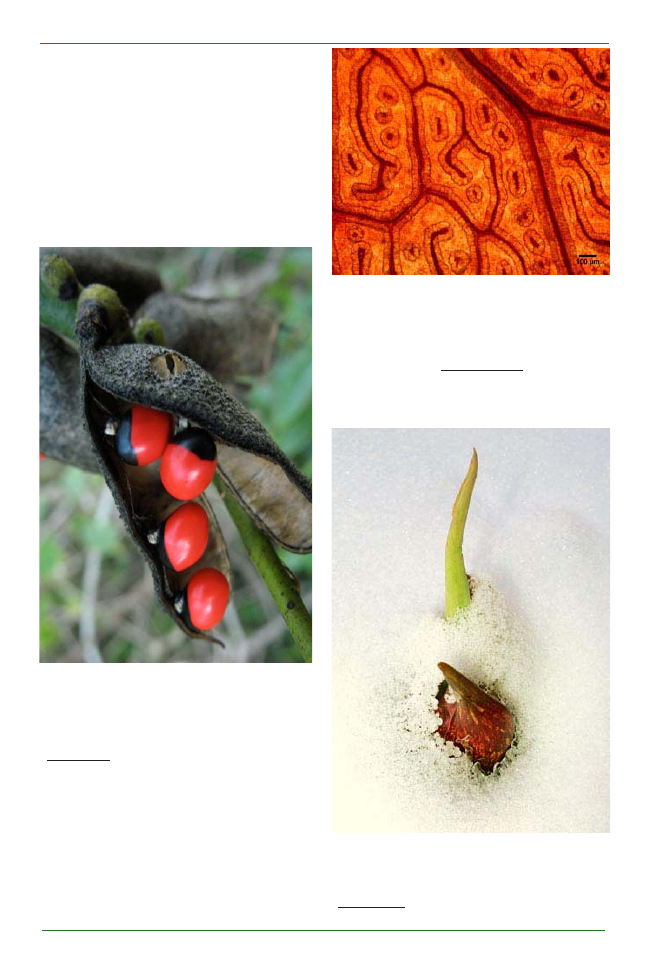
5 6
Plant Science Bulletin 56(2) 2010
Triarch “Botanical Images”
Student Travel Awards
This award provides acknowledgement and
travel support to BSA meetings for outstanding
student work coupling digital images
(botanical) with scientific explanations/
descriptions designed for the general public.
Lachezar Nikolov, Jabberwacky, Harvard
University, Cambridge, MA - Advisor, Dr.
Charles C. Davis
- First Place - $500 Botany 2010 Student Travel
Award
Margaret Sporck, Disjunct Veins of Euphorbia
rockii, University of Hawai’i, Manoa, HI - Advisor,
Dr. Lawren Sack - Second Place - $250 Botany
2010 Student Travel Award
Wenchi Jin, Heater in the snow, University of
Michigan, Ann Arbor, MI - Advisor, Dr. Paul Berry
- Third Place - $150 Botany 2010 Student Travel
Award
See all 2010 TRIARCH "Botanical Images"
Student Travel Award entries at:
h t t p : / / w w w . b o t a n y . o r g / p l a n t i m a g e s /
ConantSTA2010.php#3
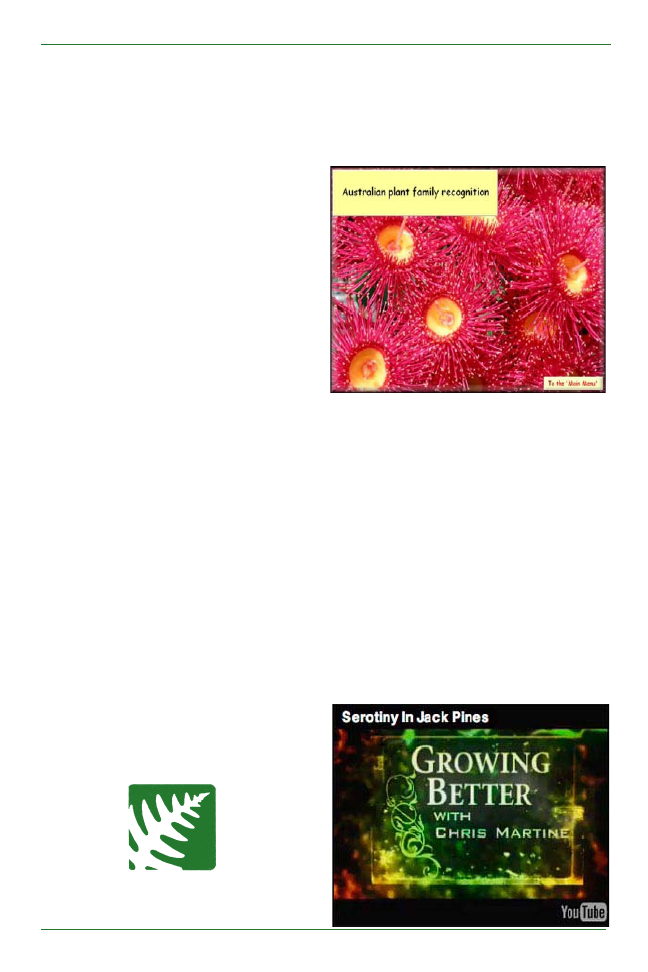
5 7
Plant Science Bulletin 56(2) 2010
The BSA Undergraduate
Student Research Awards
The BSA Undergraduate Student Research
Awards support undergarduate student
research and are made on the basis of research
proposals and letters of recommendations.
The 2010 award recipients are:
Amanda Bieber, Old Dominion University,
Norfolk, VA, - Advisor, Dr. Lytton Musselman,
Molecular identification of potentially invasive
Cuscuta in Brunei Darussalam
Sasha Dow-Kitson, , SUNY Plattsburgh,
Plattsburgh, NY, - Advisor, Dr. Chris Martine,
Reproductive biology of Hydrocharis morsus-
ranae in Lake Champlain, a likely source
population for the next region-wide aquatic
plant invasion
Elizabeth Lavoie, SUNY Plattsburgh,
Plattsburgh, NY, - Advisor, Dr. Chris Martine, A
new species of wild eggplant, with implications
for the evolution of a rare breeding system
Alexander R. Scharf, SUNY Plattsburgh,
Plattsburgh, NY, - Advisor, Dr. Chris Martine,
Chromosome number in Solanum sejunctum:
The potential role of polyploidy in the origin of
an Australian dioecious species
Paige Swanson, Colorado State University,
City, ST, - Advisor, Dr. Pam Diggle, The Role of
Branching Control Genes in Mimulus guttatus
Wes Testo, Colgate University, Hamilton, NY,
- Advisor, Dr. James E. Watkins, Jr., Desiccation
tolerance and calcium requirements of
gametophytes of American Hart’s-Tongue Fern,
Phyllitis scolopendrium var. americana
Charles Edwin Bessey Award
(BSA in association with the Teaching
Section and Education Committee)
Dr. Geoff Burrows, Charles Sturt University,
Wagga Wagga NSW, Australia.
Dr. Burrows, Senior Lecturer in Plant Sciences,
has produced a number of online teaching
applications to introduce students to
botanyincluding the most recent, plant family
recognition, They are available at:
http://www.csu.edu.au/herbarium/
Dr. Chris Martine, State University of New York
at Plattsburgh.
Dr. Martine is exploring YouTube video as a
means of introducing plants to students (see
BSA website). He also advises the active BSA
Student Chapter at SUNY Plattsburgh - - check
them out!

5 8
Plant Science Bulletin 56(2) 2010
Darbaker Prize
The Darbaker Prize in Phycology is given each
year in memory of Dr. Leasure K. Darbaker. It
is presented to a resident of North America for
meritorious work in the study of microscopic
algae based on papers published in English by
the nominee during the last two full calendar
years. This year The Darbaker Award for
meritorious work on microscopic algae is
presented to:
Dr. Brian Palenik, Scripps Institution of
Oceanography, University of California, San
Diego, CA. Dr. Palenik is a leader in the field of
oceanographic phytoplankton genomics. He
has focused mostly on cyanobacterial
organisms, but he was also first author on a
seminal paper on Ostreococcus, the smallest
eukaryotic phytoplankter whose genome was
sequenced in its entirety. Palenik was the lead
scientist in that effort, published in PNAS. In
addition to his research, Dr. Palenik is active in
communicating the science of genomics and
oceanography to the general public. He was
also instrumental in designing and
implementing an exhibit in a public aquarium
on DNA sequencing and genomics of marine
organisms.
The BSA Graduate Student
Research Award including the J. S.
Karling Award
The BSA Graduate Student Research Awards
support graduate student research and are
made on the basis of research proposals and
letters of recommendations. Withing the award
group is the Karling Graduate Student Research
Award. This award was instituted by the Society
in 1997 with funds derived through a generous
gift from the estate of the eminent mycologist,
John Sidney Karling (1897-1994), and supports
and promotes graduate student research in
the botanical sciences. The 2008 award
recipients are:
J. S. Karling Graduate Student Research
Award
Michael Gruenstaeudl, University of Texas at
Austin, Austin, TX - Advisor, Dr. Robert K. Jansen,
Correlated Diversification of Vascular Plants
and Associated Arbuscular Mycorrhizal Fungi
– A Case Study
BSA Graduate Student Research Awards
Tanya Cheeke, Portland State University,
Portland, OR - Advisor, Dr. Mitchell B. Cruzan,
Effects of genetically modified Bt maize on
symbiotic fungi in the soil ecosystem
Megan DeMarche, Colorado State University,
Fort Collins, CO - Advisor, Dr. Amy L. Angert,
EThe Evolution of Reproductive Isolation
through Divergent Adaptation
Jessica Forrest, University of Toronto, Toronto,
OT, Canada - Advisor, Dr. James D. Thomson,
Testing adaptive explanations for floral
variation in Mertensia fusiformis
(Boraginaceae)
Caitlin E. Lee, Portland State University,
Portland, OR, - Advisor, Dr. Mitchell B. Cruzan,
Effects of Invasive Plants on Native Symbiotic
Soil Fungi in Oregon Forests
Lucas C. Majure, University of Florida,
Gainesville, FL - Advisors. Dr. Douglas E. Soltis,
Dr. Pamela S. Soltis and Dr. Walter Judd, The
systematics and evolution of the Opuntia
humifusa complex (Opuntioideae: Cactaceae)
George A. Meindl, University of Pittsburgh,
Pittsburgh, PA - Advisor, Dr. Tia-Lynn Ashman,
Assessing the potential for cascading effects of
soil heavy metals: plants and pollinators
Kristin I. Powell, Washington University, St.
Louis, MO - Advisors, Dr. Tiffany M. Knight,
Understanding scale-dependent effects of plant
invaders on native biodiversity through
differential effects on common and rare species
Emily B. Sessa, University of Wisconsin,
Madison, WI - Advisor, Dr. Thomas J. Givnish,
Phylogeny, Reticulate Evolution, and Recurrent
Polyploid Speciation in North American
Dryopteris (Dryopteridaceae)
Seema N. Sheth, Colorado State University,
Fort Collins, CO, - Advisor, Dr. Amy L. Angert,
Role of evolutionary potential in limiting species’
distributions

5 9
Plant Science Bulletin 56(2) 2010
Ecology Section Student Travel Awards
Tanya Cheeke, Portland State University,
Portland, OR - Advisor, Dr. Mitchell B. Cruzan -
Botany 2010 presentation: “Transgenic Bt
maize: An evaluation of nine different Bt maize
isolines on arbuscular mycorrhizal fungi.”
Keith Bowman, SUNY College of Environmental
Science and Forestry, Syracuse, NY - Advisor,
Dr. Dr. Robin Kimmerer - Botany 2010
presentation: “The influence of the diaspore
(propagule) bank and diaspore rain on
bryophyte (moss) community composition in
northern white cedar swamps” and “Bringing
mosses into the K-12 classroom.”
Southeastern Section - Association of
Southeastern Biologists, Asheville, North
Carolina, April 9, 2010 Poster/Paper Awards
Best Paper Award $300 - Chris Stoehrel,
Western Carolina University, Cullowhee, NC -
presentation:
“Phylogeny of the Trillium erectum complex.”
Best Poster Award $300 - Mae Kile, University
of Tennessee at Chattanooga, TN -
presentation: “Scutellaria Montana
(Lamiaceae) 2009 Monitoring at the Volunteer
Training Site, Tennessee Army National Guard,
Catoosa Co., Georgia.”
The BSA Young Botanist Awards
The purpose of these awards are to offer
individual recognition to outstanding graduating
seniors in the plant sciences and to encourage
their participation in the Botanical Society of
America.
The 2010 “Certificate of Special
Achievement” award recipients are:
Elizabeth Archer, Connecticut College, New
London, CT - Advisor, Dr. T. Page Owen , Jr.
Asha Bertsch, University of Florida, Gainesville,
FL - Advisor, Dr. Pam Soltis
Paul CaraDonna, Humboldt College, Arcata,
CA - Advisor, Dr. Erik S. Jules
Bradley Daugherty, Eastern Illinois University,
Charleston, IL - Advisor, Dr. Nancy Coutant
William Davis, University of Akron, Akron, OH -
Advisor, Dr. Jean Pan
Ryan Folk, University of Akron, Akron, OH -
Advisor, Dr. Randall Mitchell
Benjamin Gahagen, James Madison
University, Harrisonburg, VA - Advisor, Dr.
Conley K. McMullen
Paul Galewski, University of Wisconsin,
Milwaukee, WI - Advisor, Dr. Sara Hoot
Liahna Gonda-King, St. Mary’s College of
Maryland, St. Mary’s City, MD - Advisor, Dr. Chris
Tanner
Sam Isham, Colorado College, Colorado
Springs, CO - Advisor, Dr. Tass Kelso
Daniel Koenemann, University of Vermont,
Burlington, VT - Advisor, Dr. David S. Barrington
Elizabeth Lavoie, SUNY Plattsburgh,
Plattsburgh, NY - Advisor, Dr. Christopher T.
Martine
Natalie Ma, University of California, Los
Angeles, CA - Advisor, Dr. Ann M. Hirsch
Lindsey McLemore, University of Florida,
Gainesville, FL - Advisor, Dr. Pam Soltis
Lydia Meador, Oklahoma State University,
Stillwater, OK - Advisor, Dr. Janette Sheets
Jacqueline Nguyen, University of California,
Los Angeles, CA - Advisor, Dr. Ann M. Hirsch
Anthony Porreca, Eastern Illinois University,
Charleston, IL - Advisor, Dr. Janice M. Coons
Jillian Post, SUNY Plattsburgh, Plattsburgh,
NY - Advisor, Dr. Christopher T. Martine
Zak Ratajczak, Vassar College,
Poughkeepsie, NY - Advisor, Dr. David P. Gillikin
Sadie Todd, Chicago Botanic Garden, Glencoe,
IL - Advisor, Dr. Krissa Skogen
Dragana Trninic, Miami University, Oxford, OH
- Advisor, Dr. John Z. Kiss
Alexia Vandeventer, University of Florida,
Gainesville, FL - Advisor, Dr. Pam Soltis
Hannah Vietmeier, Willamette University ,
Salem, OR - Advisor, Dr. Susan R. Kephart
Margaret Vincent, Miami University, Oxford,
OH - Advisor, Dr. John Z. Kiss
Rebecca Williams, Miami University, Oxford,
OH - Advisor, Dr. John Z. Kiss
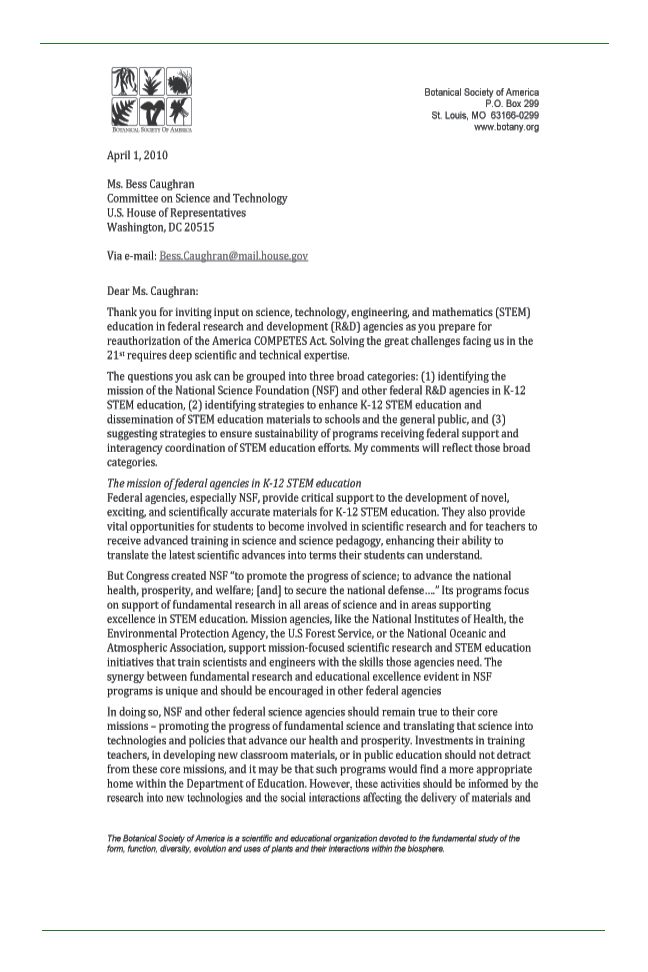
6 0
Plant Science Bulletin 56(2) 2010

6 1
Plant Science Bulletin 56(2) 2010
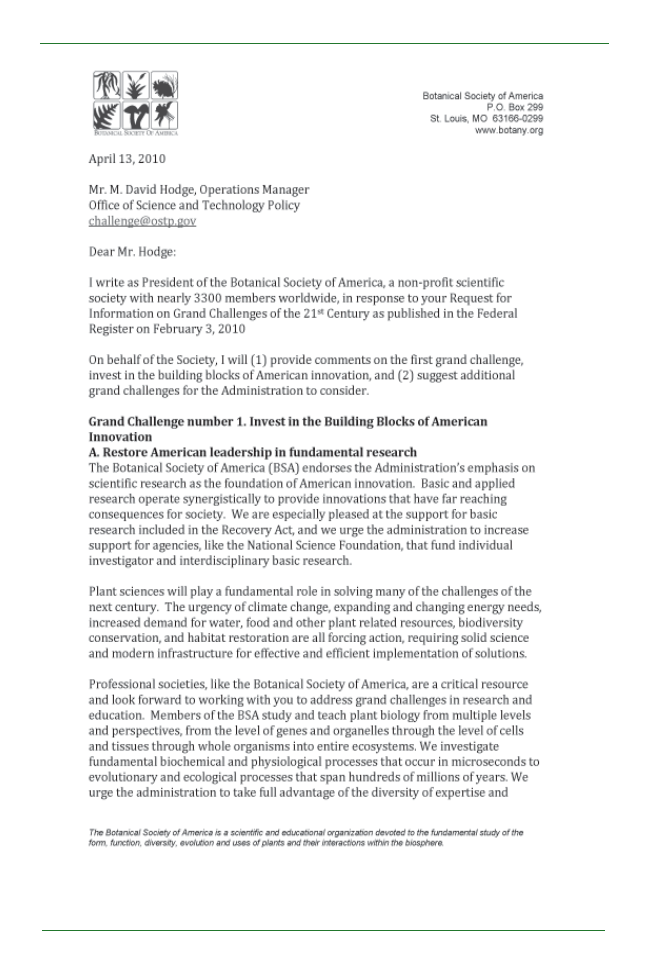
6 2
Plant Science Bulletin 56(2) 2010
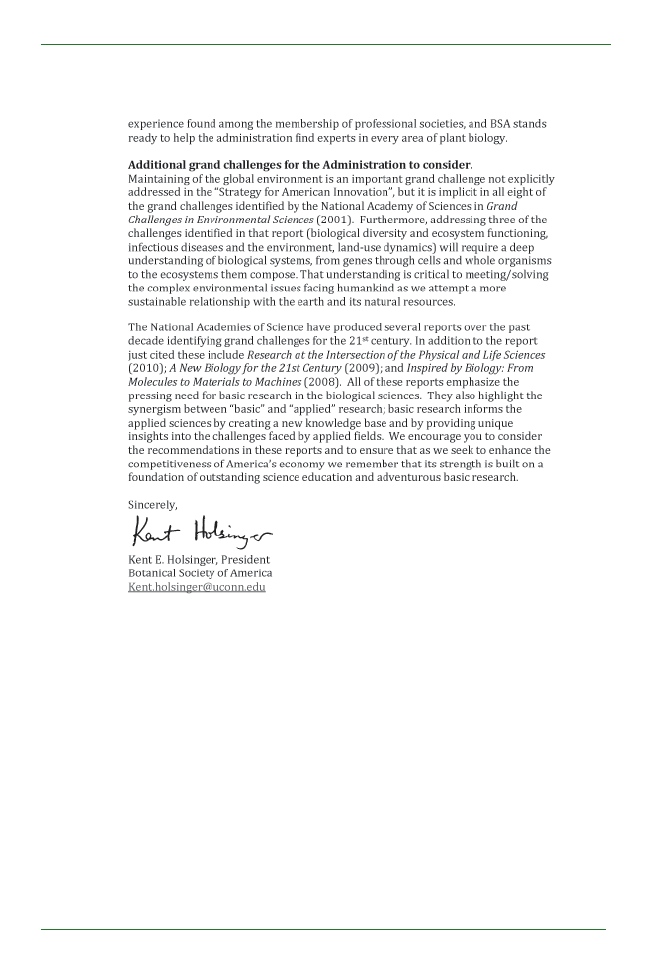
6 3
Plant Science Bulletin 56(2) 2010
BSA Science Education
News and Notes
BSA Science Education News and Notes is a
quarterly update about the BSA’s education
efforts and the broader education scene. We
invite you to submit news items or ideas for
future features. Contact: Claire Hemingway,
BSA Education Director, at
chemingway@botany.org
or Marshall
Sundberg, PSB Editor, at
psb@botany.org
.
PlantingScience — BSA-led student research
and science mentoring program
Thanks to your volunteer time this Fall 2009
and Spring 2010 sessions, over 650 student
teams in 56 classes had the opportunity to
communicate online with scientists while
conducting plant investigations in their
classrooms. Your contributions make this
program possible. Thank you for joining your
efforts with 430 scientists from 13 scientific
societies to make a difference in botanical
education.

6 4
Plant Science Bulletin 56(2) 2010
Students tell us that, as online mentors, you
help open up new possibilities for how they
experience science and understand plants.
“… the exchange in communication with the
mentor having a good mentor is key to your
projects success.” — Springfield High School
student
“…liked that we didn’t know what was going to
happen before we did the experiment. Instead
of being taught something and then just doing
an experiment to prove it, we made an attempt
to find out what would happen ourselves.” —
Fallston High School student
“I actually understand photosynthesis much
better.” — C.H. Yoe School High student
“Something that I liked most and was one of my
favorite parts about this project was how we
could take care of one thing by ourselves and
we could also record data. We could also find
and discover new imformation that we couldn’t
get anywhere else.” — St. Bridget Assumption
Middle School student
“I found it to be very informative, and it helped
me to use the scientific method. Along with
realizing how much every day life envolves the
scientific method.” — David Hinson Middle
School student
During this academic year, we continued field-
testing of genetics (Brassica and Arabidopsis
strands) and pollination modules, and this
spring saw the first classroom tests of new
Celery Challenge and C-Fern® modules.
This spring also included two pilots of new
collaborations and extensions of
PlantingScience:
·Science clubs in the 4-H SET
·A Dutch version of the program led by Edith
Jonker as a collaboration between
Wageningen University and Dutch pre-college
students
http://www.wur.nl/UK/newsagenda/
news/Dutch_preuniversity_VWO_students_work_
with_Wageningen_University_scientists_online_.htm
Over the summer, we will be busy offering
workshops, recruiting new teachers and
mentors for the fall session, and making project
improvements. Please send any suggestions
to
psteam@plantingscience.org
.
Summer workshop offerings are scattered
across the country. Texas A&M University
continues its fine hosting job for the
PlantingScience and Plant IT workshops,
thanks to the tremendous contributions of co-
PI Carol Stuessy and her graduate students
handling site coordination and education
research.
PlantingScience Summer Institute for Teachers
(June 21-29):
Wonder how to actively engage your students
in explorations of cell structure and alternation
of generations? Botanists Marshall Sundberg
and Renee Lopez-Smith will guide 16 teachers
in explorations the new Celery Challenge and
C-Fern modules. Following 5 days immersed
in the inquiries and working in teams on the
platform, teachers will focus on tailoring a
PlantingScience inquiry for their class.
PlantIT Summer Institute for Teachers
(July 12-23):
Bioinformatics and natural fiber textiles will be
the focus of investigative cases led by botanist
Ethel Stanley and master teacher Toni Lafferty.
This summer will be the final two-week teacher
professional development workshop, open to
teachers from across the country, and a one-
week student career camp, especially for Texas
high school students. If you visit
www.myPlantIT.org
this July, you’ll find new
cases, resources, datasets and tools for using
plant investigative cases.
PlantingScience Brassica Genetics Workshop
(July 9-10):
Wisconsin Fast Plant Developer Paul Williams
and plant geneticist Amber R. Smith are
developing the PlantingScience Brassica
module, a guided inquiry into phenotypic
variation in a population and patterns of
inheritance. They will lead a special 2-day
Brassica Genetics workshop this July 9-10 in
Madison, Wisconsin. This free workshop is
open to both high school teachers and scientists.
Fostering Student Thinking Through Mentoring
Workshop (Aug. 1):
Attending Botany 2010? Don’t miss the chance
to share ideas in an interactive session Sunday
morning, Fostering Student Scientific Thinking

6 5
Plant Science Bulletin 56(2) 2010
through Mentoring. Join PlantingScience
mentors Eric Jones, Laura Super, Laura
Lagomarsino, and Lindsey Tuominen to focus
on means for engaging students in formulating
scientific research questions, honing critical
thinking skills, guiding students through testing
hypotheses, challenges and benefits of
mentoring online.
Register for this free ticketed event on the
Botany 2010 web site
’09-‘10 Master Plant Science Team Thanks
Members of the Master Plant Science Team
are a special group of primarily graduate
students who receive a few perks for their
commitment to serve for an academic year and
mentor ~4 teams in both the fall and spring
session.
Our deep thanks to the 2009-2010 Master
Plant Science Team. We are grateful for your
extra mentoring efforts and extend additional
thanks to those contributing to field-testing
new inquiries, working with the materials and/
or the student teams.
The Botanical Society of America sponsored:
Tatiana Arias, Kevin Badik, Alona Banai,
Michelle Brower, Asha Brunings, Tamrya
d’Artenay, Nick DeBoer, Charlotte Germain-
Aubrey, Kate Hertweck, Sean Hoban, Bridget
Jacobs, Eric Jones, Laura Lagomarsino, Dr.
Jason Lando, Kathryn Marsh, Dr. David
Matlaga, Taina Price, Patricia Ryberg, Maggie
Sporck, Laura Super, Lindsey Tuominen,
Genevieve Walden, and Nicole Ward.
The American Society of Plant Biologists
sponsored: Rob Baker, Brunie Burgos, Kelly
Gillespie, Lisa Kanizay, William Perez, Josh
Rosnow, and Amber Robertson Smith.
Call for 2010-2011 ApplicationsWould you
like to join the 2010-2011 Master Plant Science
Team? Graduate students and post-doctoral
researchers are particularly invited to apply.
Members commit to mentoring in both the Fall
and Spring sessions of the 2010-2011
academic year. For information on perks
(including free membership for the year) and
requirements, see the Scientist page on
www.plantingscience.org
. An application is
available online:
h t t p : / / w w w . p l a n t i n g s c i e n c e . o r g /
MPSTApplication/html
Science Education Bits and Bobs
Where are the women scientists and engineers?
— In Why so Few? (2010), the AAUW
comprehensively reviews long-term data on
gender differences at key phases in the pipeline:
high school preparation, advanced placement
tests, first-year students’ intent, bachelor’s
degrees, doctorates, and workforce
representation. There is good news in the
report, such as substantial increases in the
percentage of women earning doctorates in
the biological and agricultural sciences (48%
in 2006 vs. 12% in 1966). The report also
examines barriers and bases that influence
the number of women students and faculty
members.
h t t p : / / w w w . a a u w . o r g / l e a r n / r e s e a r c h /
whysofew.cfm
How many students are earning online? —
Findings from over 200 colleges and
universities are summarized in the Babson
Survey Research Group’s 7
th
Annual Report
Online Learning in US Higher Education. Over
4.6 million students took at least one online
course in the fall 2008 term. Demand for online
learning opportunities continues to grow, and
growth in online enrollments exceeds the
growth of the overall higher education student
population. Has faculty acceptance of online
teaching and learning grown? Do they receive
training for online teaching? What is impact of
the economy on online education? These are
a few of the questions addressed in this survey.
http://www.sloanconsortium.org/publications/
survey/index
Point and counter-point on garden-based
education in the popular ress — School and
community gardens used as learning
environments are on the rise in the U.S. With
their increase in popularity comes attention to
outcomes. Articles published earlier this year
in the Atlantic Monthly and Salon air differences
in opinion on the value of gardens as educational
environments.
http://www.theatlantic.com/doc/201001/
school-yard-garden
h t t p : / / s a l o n . c o m / l i f e / e d u c a t i o n /
i n d e x . h t m l ? s t o r y = / f o o d / 2 0 1 0 / 0 1 / 1 5 /
school_gardens_strike_back_at_flanagan

6 6
Plant Science Bulletin 56(2) 2010
Editor’s Choice
Charles Darwin’s Botanical Investigations.
Harley, Suzanne M. The American Biology
Teacher 72: 77-81.
This is a good brief introduction for
undergraduate and school students to three of
Darwin’s botanical works: On the Various
Contrivances by Which British and Foreign
Orchids are Fertilized by Insects; The Different
Forms of Flowers on Plants of the Same
Species; and Insectivorous Plants. My only
disappointment is that while The Movements
and Habits of Climbing Plants and The Power
of Movement of Plants are mentioned in a
table, they are not also covered in the text, and
Animals and Plants under Domestication is
not mentioned at all.
Plants in Your Ants: Using Ant Mounds to Test
Basic Ecological Principles. Zettler, Jennifer
A., Alexander Collier, Bil Leidersdorf,and Missa
Patrick Sanou. The American Biology Teacher
72: 172-175.
For those of you in the south, here is an inquiry
that will put those ubiquitous fire ant hills to
good use. The initial activity is a basic “Fast
Plants” growth study using soil from active and
abandoned fire ant mounds as the variables.
This opens up to a variety of ecological
questions that small student groups can
pursue as projects.
University Facilities as Real-World Foci of
Multidisciplinary Science Learning. Wojdak,
Jeremy, Judy Guinan, Joseph Wirgau, Charles
Jugler, Georgia Hammond, Christine Small,
Charles Manyara, Frederick Singer, Chester
Watts, Bethany Bodo, and Andrew Baldwin.
Journal of College Science Teaching XXXIX: 8-
16.
This article reminded me of the University of
British Columbia (see Plant Science Bulletin
55(1):20-23), but with a vengeance. Radford
University designed a storm water remediation
wetland, with input from faculty, to collect
campus runoff and facilitate multidisciplinary
science learning. The constructed wetland is
used by four departments in seven of their
courses: Introductory Biology, Microbiology,
Pollution Biology, Ecology, Geography,
Hydrogeology, and Chemistry integrated by an
annual “Wetland Forum.” It’s too bad there’s no
botany course to share the wealth.
Plenary Lecture
Kenneth R. Miller
Kenneth R. Miller is Professor of Biology and
Royce Family Professor for Teaching
Excellence at Brown University. A cell biologist,
he serves as an advisor on life sciences to the
NewsHour, a daily PBS television program on
news and public affairs, and is a Fellow of the
American Association for the Advancement of
Science (AAAS). Miller is coauthor, with Joseph
S. Levine, of five different high school and
college biology textbooks used by millions of
students nationwide. In 2005 he served as lead
witness in the trial on evolution and intelligent
design in Dover, Pennsylvania. His popular
book, Finding Darwin’s God: A Scientist’s Search
for Common Ground between God and
Evolution, addresses the scientific status of
evolutionary theory and its relationship to
religious views of nature. His latest book, Only
a Theory: Evolution and the Battle for America’s
Soul addresses the continuing struggle over
how evolution is to be understood in American
society. His honors include the Presidential
Citation of the American Institute of Biological
Science (2005), the Public Service Award of the
American Society for Cell Biology (shared with
Dr. Barbara Forrest in 2006), and the
Distinguished Service Award of the National
Association of Biology Teachers (2008). In 2009,
Miller was honored with the AAAS Public
Understanding of Science and Technology
Award, and with the Gregor Mendel Medal,
presented by Villanova University. He has twice
been a guest on the Colbert Report.
In addition to the Plenary lecture, Dr. Miller will
be presenting a workshop/discussion on
Some Highlights at the Upcoming
Annual Meeting

6 7
Plant Science Bulletin 56(2) 2010
Saturday morning from 10am - noon.
Teaching Evolution: A Discussion
Dr. Ken Miller will join us for a discussion of the
challenges instructors face when they teach
evolutionary theory. This is an opportunity to
bring your questions and successes to share
with the group. This discussion will be
especially useful for those new to teaching
evolution, and those dealing with
heterogeneous student populations, such as
community colleges.
Women in Science Luncheon
“Creating Change in Scientific Institutions
through Subversion, Revolution, and
Meteorology.” Enjoy lunch and networking –
with guest speaker Dr. Debra Rolison, Naval
Research Laboratory. 12:00 pm to 1:00 pm
$30.00 Students $15.00 This is an event for
ALL botanists and men are encouraged to
attend and support their female colleagues,
not only at this event at our meeting in
Providence, but at their home institutions!
Regional Botany Lecture
Elizabeth Farnsworth
Elizabeth Farnsworth is Senior Research
Ecologist with the New England Wild Flower
Society (NEWFS), and a biologist, educator,
and scientific illustrator. She is currently
principal investigator on a National Science
Foundation-funded project to develop an on-
line guide to the regional flora for teaching
botany. She previously coordinated NEWFS
planning for the conservation and
management of over 100 species of rare plants.
She has illustrated the forthcoming Flora of
New England for NEWFS and the Natural
Communities of New Hampshire with the NH
Natural Heritage Bureau, and is currently
illustrating The Ants of New England (Yale
University Press). She is co-author of the
Connecticut River Boating Guide: Source to
Sea and the Peterson Field Guide to the Ferns.
She is a member of the graduate faculties of
the University of Massachusetts at Amherst
and the University of Rhode Island, a Master
Teacher at the Conway School of Landscape
Design, and has taught at Smith College and
Hampshire College. She formerly served as
Ecologist with the Connecticut Chapter of The
Nature Conservancy. She has conducted
scientific research on many ecosystems
throughout the world, focusing on restoration,
conservation, and climate change. She was
awarded a Bullard Research Fellowship by
Harvard University in 2005 and a National
Science Foundation Postdoctoral Fellowship
in 1999. She has been a scientific consultant
to the National Park Service, The Trustees of
Reservations, U. S. Forest Service,
Massachusetts and Connecticut Natural
Heritage Programs, United Nations, and the
Mount Grace Land Conservation Trust. She
obtained her Ph.D. in biology from Harvard
University, M. Sc. from the University of Vermont,
and a B.A. with honors in Environmental Studies
from Brown University. She is Editor-in-Chief of
the botanical journal, Rhodora.
Kaplan Memorial Lecture
Dr. Nancy Dengler
Inside Leaf Development.
Land plants display a striking diversity of external
morphologies. Leaf size and shape are major
contributors to this multiplicity of plant form in
the natural world. Mature function of all leaves
depends on the developmental coordination of
leaf morphogenesis with the processes that
give rise to cells and tissues on the inside of the
leaf.. During development within the shoot tip,
leaf shape is manifested very early, as basic
leaf symmetry and sub-regions are apparent
almost from inception on the shoot apical
meristem. Initial leaf shape, as expressed
during early primary morphogenesis, can be
highly altered during leaf expansion and
secondary morphogenesis, however.
Histogenesis of internal tissues runs in parallel
with the time course of morphogenesis: tissue
patterning occurs during the earliest
developmental stages, cell enlargement alters
and enhances the initial differences among
the tissue systems as leaves expand, and full
cell differentiation is completed late, often after
leaves reach full size. The diversification of
photosynthetic pathways in the genus Flaveria
(Asteraceae) provides a suitable model to
examine some developmental links between
morphogenesis and histogenesis and
highlights how small developmental shifts can
have large implications for mature form and
function.

6 8
Plant Science Bulletin 56(2) 2010
Missouri Botanical Garden
Board of Trustees Appoints
Dr. Peter Wyse Jackson
as Successor to Garden
President Dr. Peter H. Raven
Wyse Jackson is the Director of the National
Botanic Gardens in Dublin, Ireland
St. Louis, MO:The Missouri Botanical Garden’s
Board of Trustees has appointed Dr. Peter
Wyse Jackson, director of the National Botanic
Gardens of Ireland in Dublin, as successor to
internationally renowned Garden President Dr.
Peter H. Raven.
With the Garden’s Board of Trustees, Peter
Raven played an integral part in the selection
process and will play a key role in the future,
especially during the 2010-2011 transition
period.
Recognized as one of the world’s leading
botanists and advocates of conservation and
biodiversity, Raven transformed the Garden
into a world-class center for botanical research,
education and horticultural display. He is known
globally as an advocate for preserving plant
diversity in the face of deforestation, degradation
and global warming. In addition, Raven is
credited for putting a spotlight on the growing
problem of nature-deficit disorder, speaking
about the need to instill in children a love of
nature that will translate into concerned adults.
The recipient of hundreds of awards and
accolades over his 40 year tenure, Raven holds
the country’s highest award for scientific
accomplishment, the U.S. Medal of Science.
“I am extremely pleased with the selection of Dr.
Peter Wyse Jackson as the next president of the
Missouri Botanical Garden,” said Raven. “He
brings not only a wealth of horticulture and
botanical experience, but also a deep
understanding of the importance of
sustainability and conservation.”
Born in Kilkenny, Ireland, and educated at the
University of Dublin, Trinity College, Peter Wyse
Jackson has served as the director of the
Personalia
Professor John L. Harper FRS
CBE (1925-2009)
Professor John Lander Harper, corresponding
member of the Botanical Society of America,
revolutionized plant ecology. “He brought
population biology and experimental
approaches into the forefromt of plant ecology,
linking demography and selection, and
therefore ecology and evolution.”
“John Harper’s accomplishments and
authority in the field of plant population biology
gained him much international recognition.
From 1971-1998 he served in various advisory
roles for bodies including the Natural
Environmentat Research Council, the Royal
Society, the Agricultural and Food Research
Council, the Comite’ de Direction CEPE
(CNRS), the Joint Nature Conservation
Committee, and as a Trustee of the British
Museum of Natural History. He also held
various editorial roles including Editor-in Chief
of Agroecosystems (1974-1981), Co-Editor of
Oecologia (1982-94), Assistant Editor,
Philosophical Transactions of the Royal
Society of London B (1992-98). He was
President of the British Ecological Society
(1966-7), elected to the Royal Society of London
(1978), and Honorary Associate of the Swedish
Society for Phytogeography (1981), a Foreign
Associate of the US National Academy of
Sciences (1984), named “Eminent Ecologist”
by the Ecological Society of America,” and
Corresponding Member of the Botanical
Society of America. “In 1999, the International
Botanical Congress awarded him the Millennial
Medal, and the British Ecological Society gave
him the Marsh Award in 2000.”
For a more complete notice see the obituary by
R. Turkington in:
Journal of Ecology 97(5): 835-837.
In Memoriam

6 9
Plant Science Bulletin 56(2) 2010
AIBS Launches Legislative
Action Center
The AIBS Legislative Action Center is an easy-
to-use tool that enables biologists and science
educators to quickly and effectively
communicate with their elected officials.
Each day lawmakers make tough decisions
about science policy. For example, members
of Congress are debating investments in
federal research programs, biodiversity
conservation, mitigation of climate change,
and the opportunities of stem cell research for
new medical treatments. Scientists now have
the opportunity to help their elected officials
understand the importance of these issues to
the scientific research and education
communities.
Become an advocate for your science and
profession. Visit the AIBS Legislative Action
Center and become an advocate for biology.
The AIBS Legislative Action Center is made
possible by the generous contributions of AIBS
Member Societies. The Society for the Study of
Evolution, American Society for Limnology and
Oceanography, Association of Ecosystem
Research Centers, and the Botanical Society
of America have made generous financial
contributions to support this important initiative.
Announcements
National Botanic Gardens of Ireland since
March 2005. During his tenure, Wyse Jackson
placed a new emphasis on organic horticulture
and home gardening. He made environmental
sustainability a priority of the institution,
reducing waste and energy consumption,
promoting new programs and research on
biodiversity, conservation and sustainable
development. In addition, Wyse Jackson
introduced a wide range of new cultural
programs to the Garden, and secured for
Ireland the fourth Global Botanic Gardens
Congress, which will be hosted by the National
Botanic Gardens in June 2010. In Ireland, he
has also been a leader at national levels in
environmental policy development, providing
advice to government in fields including
biodiversity, conservation and climate change.
Prior to his position with the National Botanic
Gardens, Wyse Jackson served as secretary
general for the Botanic Gardens Conservation
International (BGCI), a chief executive position
charged with leadership of the organization.
BGCI is a worldwide organization promoting
plant conservation, environmental education
and sustainable development through botanic
gardens.
Wyse Jackson is the author of scores of
scientific books and papers on plant
conservation, gardening and horticulture, Irish
floristics and plant systematics, and the
management and conservation of endangered
island floras. He brings to the Missouri Botanical
Garden an extensive knowledge of botanical
institutions, having worked closely with botanic
gardens in more than 50 countries. He is
globally renowned, and has served as Chair of
the Global Partnership for Plant Conservation
since 2005, supporting the implementation of
the U.N.’s Global Strategy for Plant
Conservation.
“The Missouri Botanical Garden is one of the
top botanical institutions in the world,
internationally known for its global scientific
endeavors and as a cultural institution,” said
Wyse Jackson. “It is an honor to have been
selected for the presidency at this prestigious
institution. The great challenges that we face
worldwide in securing a sustainable
environment for the future place great
responsibilities to provide continued
leadership through such great institutions as
the Missouri Botanical Garden. I look forward to
working with the wonderful staff and leading
this already superb center of science and
horticultural display to even greater heights.”
“The Garden has been fortunate to benefit from
the long and rich tenure of Peter Raven. He has
put Missouri on the global map,” noted Arnold
Donald, Chair of the Garden’s Board of
Trustees. “Going forward, we are in excellent
hands with Peter Wyse Jackson, who will
continue Peter Raven’s outstanding legacy in
both horticultural displays and science and
conservation.”
Peter Wyse Jackson and his wife, Diane, have
three children.

7 0
Plant Science Bulletin 56(2) 2010
Hunt Institute Announces
Rogers McVaugh Gift
Pittsburgh, PA—The Hunt Institute is honored
to announce that the late taxonomist and
botanical explorer Rogers McVaugh (30 May
1909–24 September 2009), a member of the
original Hunt Botanical Library advisory board
and a longtime supporter of the Hunt Institute’s
mission, has bequeathed the remainder of his
academic research papers and books to Hunt
Institute. Dr. McVaugh was internationally
renowned for his expertise in Compositae,
Myrtaceae, Campanulaceae, woody
Rosaceae, and the flora of Mexico, as well as
in botanical history and nomenclature. He spent
much of his career at the University of Michigan,
where he was curator of vascular plants (1946–
1979) and director of the herbarium (1972–
1975). He retired in 1979 and moved to Chapel
Hill, where he was appointed research
professor of botany at the University of North
Carolina and where he continued to work for
nearly 30 years. He published about a dozen
books and 200 shorter articles in the history of
botany, floristics and systematic botany. His
many awards included the Merit Award (1977)
and the Centennial Award (2006) from the
Botanical Society of America, the Gold Medal
for “Mérito Botánico” from the Sociedad
Botánica de México (1978), the Henry Allan
Gleason Award from the New York Botanical
Garden (1984), and the Millennium Medal from
the International Association for Plant
Taxonomy at the International Botanical
Congress in 1999. He was also the first
recipient of the Asa Gray Award (American
Society of Plant Taxonomists, 1984), the Luz
María Villarreal de Puga Medal (University of
Guadalajara, 1993), and the Cuatrecasas
Medal for Excellence in Tropical Botany
(Smithsonian Institution, 2001).
The donation includes McVaugh’s
professional library, his work on Flora Novo-
Galiciana, his research files on botanical
exploration, and correspondence and notes
from his years at the University of North Carolina
at Chapel Hill. The books and papers will be
deposited in the Institute’s Library and
Archives, respectively. This gift adds to the
archival material previously donated by Dr.
McVaugh, which includes his 1944–1979
correspondence and his collection of group
and individual photographs of botanists and
explorers (HI Archives McVaugh Collection no.
322).
We appreciate Dr. McVaugh’s longstanding
commitment to the Hunt Institute, and we are
committed to making the collection open to
researchers upon request. Please contact the
Library or Archives to make an appointment.
The Hunt Institute is located on the 5th floor of
the Hunt Library building at Carnegie Mellon
University. Hours: Monday–Friday, 9 a.m.–noon
and 1–5 p.m.; readers’ hours in the Library, 1–
5 p.m.; additional gallery hours on Sunday, 1–
4 p.m. during exhibitions. For further information,
contact the Hunt Institute at 412-268-2434.
The Hunt Institute for Botanical Documentation,
a research division of Carnegie Mellon
University, specializes in the history of botany
and all aspects of plant science and serves the
international scientific community through
research and documentation. To this end, the
Institute acquires and maintains authoritative
collections of books, plant images,
manuscripts, portraits and data files, and
provides publications and other modes of
information service. The Institute meets the
reference needs of botanists, biologists,
historians, conservationists, librarians,
bibliographers and the public at large,
especially those concerned with any aspect of
the North American flora.
Hunt Institute was dedicated in 1961 as the
Rachel McMasters Miller Hunt Botanical Library,
an international center for bibliographical
research and service in the interests of botany
and horticulture, as well as a center for the study
of all aspects of the history of the plant sciences.
By 1971 the Library’s activities had so diversified
that the name was changed to Hunt Institute for
Botanical Documentation. Growth in collections
and research projects led to the establishment
of four programmatic departments: Archives,
Art, Bibliography and the Library. The current
collections include approximately 29,000
books; 30,000 portraits; 30,000 watercolors,
drawings and prints; and 2,000 autograph letters
and manuscripts. The Archives specializes in
biographical information about, portraits of and
handwriting samples from scientists,

7 1
Plant Science Bulletin 56(2) 2010
Some Plants Native To NYC
Area Have Become Locally
Estinct As New Flora Has
Moved In
Brooklyn, NY—Brooklyn Botanic Garden (BBG)
announces findings from the most
comprehensive study of plant biodiversity ever
undertaken in the metropolitan New York area.
New York Metropolitan Flora Project (NYMF)
data, gathered over the course of the last 20
years, provide the first hard evidence of how
native species are faring—and how non-native
species are spreading—in counties within a
50-mile radius of New York City. The area of
study includes all of Long Island, southeastern
New York State, northern New Jersey, and
Fairfield County, Connecticut.
While much of the botanical science community
concentrates on researching and tracking the
threats to biodiversity in the tropics, scientists
at BBG have chosen to undertake an
unprecedented study of their own region.
At least 50 varieties of native plants are locally
extinct or nearing elimination, say project
scientists. Nuttall’s mudflower (Micranthemum
micranthemoides), last collected from the
region in 1918, is likely extinct throughout its
former range. Scarlet Indian paintbrush
(Castilleja coccinea), pennywort (Obolaria
virginica), sidebells wintergreen (Orthilia
secunda), and sundial lupine (Lupinus
illustrators and all others in the plant sciences.
The Archives is a repository of alternate resort
and as such has collected over 300 institutional
and individual archival collections that may not
have otherwise found an easy fit at another
institution. Including artworks dating from the
Renaissance, the Art Department’s collection
now focuses on contemporary botanical art
and illustration, where the coverage is
unmatched. The Art Department organizes and
stages exhibitions, including the triennial
International Exhibition of Botanical Art &
Illustration. The Bibliography Department
maintains comprehensive data files on the
history and bibliography of botanical literature.
Known for its collection of historical works on
botany dating from the late 1400s to the present,
the Library’s collection focuses on the
development of botany as a science and also
includes modern taxonomic monographs,
floristic works and serials.
Swingle Plant Anatomy
Reference Collection
At the University of Miami, Walter T. Swingle
completed his monograph “The Botany of
Citrus and its Relatives of the Orange
Subfamily,” which remains the premier
reference for the taxonomy, morphology, and
anatomy of these plants. With his staff, he
began the ambitious project that became the
Swingle Plant Anatomy Reference Collection,
carefully preparing thousands of microscope
slides of plant structures from tropical crops
and their wild relatives.<
http://
merrick.library.miami.edu/specialCollections/
wtswingle/
>
The Plant Anatomy Digital Archive features
over 1,700 images from more than 250 species
of plants collected from all over the world. The
images are digitized micrographs of parts of
plants that were sectioned, stained, and
permanently mounted to a glass slide. Although
the earliest specimen was collected in 1769
(Limonia acidissima L., accession number
SV221), the majority were collected in the early
20th century. The Digital Archive shows a small
selection of slides present in the Swingle
Reference Collection,which consists of 3,200
specimens on over 26,000 glass microscope
slides, from 575 plant species. Animations
were also created by transforming images of
consecutive microtome sections into individual
“frames” using JavaScript, so that time
represents movement up the axis of the plant
structure. The results provides a new
perspective on how plants are constructed in
three dimensions.
The collection is freely available for use to
support teaching and research.
Visit
http://swingle.miami.edu

7 2
Plant Science Bulletin 56(2) 2010
perennis) are among the wildflower species to
have seriously declined in the region. Black
crowberry (Empetrum nigrum) is locally extinct,
without a trace of a population remaining today
in the New York City metropolitan area.
“In many areas, the snapshot this report
provides is startlingly different from the printed
maps, plant manuals, and landscape shots of
just 40 years ago,” says Dr. Gerry Moore, director
of Science at Brooklyn Botanic Garden and
coordinator of the New York Metropolitan Flora
Project. “A number of invasive species
introduced from distant areas that have
climates similar to ours—such as parts of
Asia, Europe, and the southeastern United
States—are newly thriving in the New York City
area. For example, camphor weed, native to
the southern United States, is common in
Brooklyn now; however, at the time of the
Garden’s founding a century ago, it was
considered to be quite rare.”
Offering a precise map of as many as 3,000
plant species, the NYMF project findings are
vital reference points for those involved in
environmental efforts like conserving rare
plants, planning parks and greenways,
repairing degraded habitats, and designing
home gardens.
Although agencies and municipalities may
wish to restore native species to particular
habitats, the NYMF findings suggest that some
native species can no longer survive in their
native region. “How do you, say, restore the
flora original to a coastline, when you know that
the sea level is rising each year?” asks Dr.
Moore.
Some plants native to the region, like Britton’s
violet (Viola brittoniana), are now rare in their
natural habitats but thrive when brought into
cultivation in the metropolitan area. Some non-
native cultivated plants, such as Japanese
barberry (Berberis thunbergii), can escape
from cultivated landscapes and overrun natural
areas, where they thrive and spread, crowding
out more fragile plants. Efforts are now
underway to better recognize and manage for
invasive plant species, which can be
particularly disruptive when introduced to a
new habitat due to the absence of the insects,
diseases, and animals that naturally keep its
population in check in its native region.
Dr. Moore notes that changes to plant
biodiversity also affect insect and animal life,
as well as other aspects of the local ecosystem.
The mapping phase of the NYMF project is now
concluding, and steps are underway to create
manuals in collaboration with the U.S. Forest
Service.
“The NYMF project is a model, not only for
gathering data over time, but for applying that
data in a precise and visually-oriented way,”
says Scot Medbury, president of Brooklyn
Botanic Garden, who notes that data from the
research project will be shared with Federal
and State governments, as well as the New
York Flora Atlas, published in partnership with
the state’s Biodiversity Research Institute.
“Studying the vegetation changes in highly
populated areas is critical to understanding the
future of biodiversity in our rapidly urbanizing
world,” Medbury notes.
The study of native plants has long been a core
mission at Brooklyn Botanic Garden, which
celebrates its centennial this year. In BBG’s
early years, botanist Norman Taylor intensively
studied local flora by walking nearly 2,000 miles
over Long Island, mapping locations of plant
families. Taylor then published a book on flora
of the region, providing as clear a picture as
was possible at the time of the state of native
flora.
Today, many new plants are present in the
area. Some have been intentionally cultivated,
while others have moved here inadvertently:
brought in with soil, animals or people. “NYMF
has identified entire plant communities that
would have been unknown to Norman Taylor
and his colleagues a hundred years ago,” says
Medbury.
For more information, please visit
bbg.org/sci/
nymf/.
Past and present major funding for the New
York Metropolitan Flora project is provided by
the Andrew Mellon Foundation, Eppley
Foundation for Research, Hudson River
Watershed Foundation and New York
Biodiversity Research Institute.

7 3
Plant Science Bulletin 56(2) 2010
.
2010 Field Botany Seminars on
the Maine coast ... Advanced,
professional, specialty, and
introductory field seminars
offered by the Humboldt
Institute
http://www.eaglehill.us/programs/nhs/nhs-
calendar.shtml
Introduction to Bryophytes. May 23 - 29. Alison
C. Dibble.
Introduction to Modern Phylogenetic Methods.
May 30 - Jun 5. Brigid O’Donnell and Hillary
Manus.
Lichen Chemistry: Spot Tests and TLC in
Lichen Identification. Jun 6 - 12. Scott LaGreca
and ThorstenLumbsch.
Liverworts and Liverwort Ecology. Jun 6 - 12.
Blanka Shaw and Jon Shaw.
Sterile Crustose Lichens: An Introduction with
Special Emphasis on Identification. Jun 13 -
19. James C. Lendemer.
Sedges, Rushes, and Grasses: Advanced
Taxonomy and Ecology of Wetland and Upland
Species. Jun 27 - Jul 3. Anton A. Reznicek.
Botanical Illustration with Color Pencil. Jul 4 -
10. Wendy Hollender.
Botanical Illustration on Vellum and Paper:
Botanical Portraiture and Microlandscapes.
Jul 11 - 17. Carol Woodin.
Applied Field Identification of Sedges, Rushes,
and Grasses. Jul 11 - 17. Tyler Smith.
Forest Ecosystem Analysis for Sustained
Forestland Values and Uses. Jul 11 - 17.
Norman A. Richards
Wetland Identification and Delineation. Jul 25
- 31. Robert W. Lichvar and Russell Pringle.
Freshwater Diatoms: Taxonomy and
Biomonitoring. Jul 25 - 31. Jeffrey R. Johansen.
Salt Marsh Restoration Adapts to Global Climate
Change. Aug 1 - 7. Susan C. Adamowicz and
David
Burdick.
Mushrooms and Other Fungi. Aug 8 - 14.
Rosalind Lowen and Dianna Smith.
Lichens and Lichen Ecology. Aug 15 - 21. David
Richardson and Mark Seaward.
Bryophytes and Bryophyte Ecology. Aug 15 - 21.
Nancy G. Slack.
Crustose Lichens: Identification Using
Morphology, Anatomy, and Simple Chemistry.
Aug 22 - 28. Irwin M. Brodo.
Taxonomy and Biology of Ferns and Lycophytes,
with Guest Lectures on Isoetes. Aug 22 - 28.
Robbin Moran and W. Carl Taylor.
Plants as Alternatives to Well-known Medicines,
Spices,Teas, and Vegetables. Aug 29 - Sep 4.
James A. Duke.
Flora of Coastal Habitats and Islands of Maine.
Aug 29 - Sep 4. Glen H. Mittelhauser.
Toxic and Look-Alike Mushrooms and the
Management of Mushroom Toxicities: A
Seminar for Emergency Care and Health Care
Providers. Sep 14 - 18. John Saucier, Tamas
R. Peredy, and Lawrence Leonard.
Phytogeography and Taxonomy of the North
American Flora: Recent Advances in Digital
Technology and the Development of Digital
Floras as Research Tools. Sep 19 - 25. John
Kartesz.
Nurturing Biodiversity in the Managed
Landscape: Gardening with Native Plants,
Insects, and Wildlife. Sep 26 - 30. Marjorie
Peronto.
Information on lodging options, meals, and
costs may be found at
http://www.eaglehill.us/
programs/general/application-info.shtml
Symposia, Conferences,
Meetings

7 4
Plant Science Bulletin 56(2) 2010
Assisted Migration of Plants
A Janet Meakin Poor Research
Symposium
Chicago Botanic Garden, Glencoe, IL
June 11, 2010
In a changing climate, plant species will
respond in various ways. Some will cope by
changing their physiology, some will adapt via
natural selection, some will migrate, and
others, unable to make these changes, will go
extinct. When fragmentation limits migration
potential of plants or when natural migration
and adaptation rates are outstripped by the
pace of climate change, some conservation
biologists propose purposeful, human-
mediated migration, known as “assisted
migration” or “managed relocation,” as a way
to prevent extinction. In this symposium, we
examine this controversial topic from both sides
of the issue and suggest ways that the benefits
of assisted migration can be maximized while
the costs and risks can be minimized.
http://
www.chicagobotanic.org/school/symposia/
JMP.php
Schedule
8:30 a.m. Welcome
Moderator: Kayri Havens, Ph.D., Medard and Elizabeth
Welch Director, Plant Science and Conservation,
Chicago Botanic Garden, Glencoe, IL
8:40 a.m. Keynote Presentation
Can Plants Adapt to Climate Change? Art Weis,
Ph.D., Professor, Director, Koffler Scientific Reserve
at
Joker’s Hill, University of Toronto, Toronto, ON
9:30 a.m. Big and Little Are Not the Same: How
Range and Population Sizes Could Affect
Management Strategies Under Climate Change. Pati
Vitt, Ph.D., Curator, Dixon National Tallgrass Prairie
Seed Bank Conservation Scientist, Chicago Botanic
Garden, Glencoe, IL
10 a.m. Break
10:30 a.m. Managed Relocation
Jason McLachlan, Ph.D., Assistant Professor,
Department of Biological Sciences, Notre Dame,
Notre Dame, IN
11 a.m. Is Managed Relocation another Pathway
for Biological Invasions? Sarah Reichard, Ph.D.,
Associate Professor, School of Forest Resources,
University of Washington, Seattle, WA
Eagle Hill offers specialty seminars at different
ecological scales for those who are interested
in understanding complex natural history
questions. Seminars range from watershed
level subjects, and subjects in classical
ecology, to highly specialized seminars in
advanced biology, taxonomy, and ecological
restoration.
Eagle Hill has long been recognized as offering
hard-to-find seminars and workshops which
provide important opportunities for training and
meeting others who are likewise dedicated to
continually learning more about natural history.
Eagle Hill field seminars and workshops are
of special interest because they focus on the
natural history of one of North America’s most
spectacular and pristine natural areas, the
coast of eastern Maine from Acadia National
Park to Petit Manan National Wildlife Refuge
and beyond. Most seminars combine field
studies with follow-up lab studies and a review
of the literature. Additional information is
provided in lectures, slide presentations, and
discussions. Seminars are primarily taught
for people who already have a reasonable
background in a seminar program or in related
subjects, or who are keenly interested in
learning about a new subject.
—
Joerg-Henner Lotze
Director, Humboldt Field Research Institute
and Eagle Hill Foundation
PO Box 9, 59 Eagle Hill Road, Steuben, ME
04680-0009 United States
Phone: 207-546-2821. cell: 718-715-2824.
FAX: 207-546-3042. Skype: joergeagle
http://www.eaglehill.us

7 5
Plant Science Bulletin 56(2) 2010
Phytogeography and
Taxonomy of the North
American Flora: Recent
Advances in Digital Technology
and the Development of Digital
Floras as Research Tools
September 19 - 25, 2010
Our knowledge of North American floristics is
predicated upon four centuries of vouchered
collections that number some 80 million
records. Therefore, our basic knowledge of
floristics is no longer a mystery. By using even
antiquated floristic practices, we can generate
informative traditional floras with a great deal of
precision regarding where our 23,000 species
occur within North America, how we identify
them, which ones are rare, which ones are
exotic, what characteristics do they share, etc.
However, by applying many new and readily
available alternative technologies to these
antiquated floristic practices, new and wholly
different paradigms can be produced. From
our vast herbarium records, we know that that
there are 23,714 species of vascular plants in
North America, of which 19,402 are native,
4,366 are exotic, 2,748 are trees, 6,429 are
shrubs, etc. However, by incorporating Digital
Technology, it is also possible to show richness
and similarity coefficients of floras from different
elevations, from different ecoregions, from
different heat and hardiness zones and from
different physiographic zones. Digital
Technology can also produce species area
curves, illustrate density gradation patterns
and compare floras with similar rainfall, heat
and hardiness zone patterns. It is also possible
to monitor floristic shifts due to climate factors
such as global warming and other factors.
Moreover, by using random access keys and
digital imagery, we can produce more effective
identification systems and more accurately
pinpoint locations of individual plant
populations, or even individual plants that grow
in parks, forests or along roadsides.
This seminar will to a significant extent focus
on the U.S. Army Corps of Engineers new web
site,
https://rsgis.crrel.usace.army.mil/apex/
f?p=703
, based on the National Wetland Plant
List (NWPL), a key component of the Corps’
national wetland program. While designed to
support a project to update the NWPL, the site
includes extensive botanical information of
more general interest. Its robust search
capabilities allow users to explore a wealth of
information on nearly 10,000 U.S. wetland
plants, including detailed distribution maps
and spectacular photographs. (Non-Corps
users may need to accept a web certificate the
first time they visit the site.)
John Kartesz (
john_kartesz@yahoo.com
)
received his Bachelor’s and Master’s Degrees
11:30 a.m. Multi-stage Modeling Approach to
Evaluate Migration Potential of Tree Species under
Climate Change. Anantha M. Prasad, Ecologist,
Northern Research Station, USDA Forest Service,
Delaware, OH
Noon Lunch
1:30 p.m. Assisted Migration of Trees: a Canadian
Perspective. Tannis Beardmore, Researcher, Tree
Seed, Atlantic Forestry Centre, Natural Resources
Canada, Fredericton, NB
2 p.m. The Other Assisted Migration: Moving
Genotypes Within a Species Range . Jessica Dawn
Pratt, Vice President, OCSCB, and Ph.D. Student,
Mooney Lab, University of California at Irvine, Irvine,
CA
2:30 p.m. Stretch Break
3 p.m. Assisted Migration and Invasive Species:
Exploring an Ethical Dilemma. Jay Odenbaugh,
Associate Professor, Department of Philosophy,
Environmental Studies, Lewis & Clark College, Portland,
Oregon
3:30 p.m. Panel Discussion, Q&A
4 p.m. Posters and Lemonade
5 p.m. Adjourn
Register Now!
Call 847-835-8261 or go to
h t t p : / / w w w . c h i c a g o b o t a n i c . o r g / s c h o o l /
symposia/JMP.php

7 6
Plant Science Bulletin 56(2) 2010
Special Opportunities
MSc Degree/Postgraduate
Diploma in the Biodiversity and
Taxonomy of Plants
Royal Botanic Gardens
Edinburgh/ University of
Edinburgh
Programme Philosophy
The MSc in Biodiversity and Taxonomy of Plants
was established by the University of Edinburgh
and the Royal Botanic Garden Edinburgh
(RBGE) to address the growing worldwide
demand for trained plant taxonomists and
whole-plant scientists. A detailed knowledge
of plants and habitats is fundamental to their
effective conservation. To communicate such
knowledge accurately and effectively, training
is required in plant taxonomy – the discipline
devoted to plant diversity and evolution,
relationships, and nomenclature.
The MSc is perfect for those wishing to develop
a career in many areas of plant science:
-Survey and conservation work in threatened
ecosystems
-Assessment of plant resources and genetic
diversity
-Taxonomic research
-Management of institutes and curation of
collections
-A stepping stone to PhD research and
academic careers
Edinburgh is a unique place to study plant
taxonomy and diversity. The programme and
students benefit widely from a close partnership
between RBGE and the University of Edinburgh
(UoE). RBGE has one of the world’s best living
collections (15,000 species across our four
specialist gardens – 5% of world species), an
herbarium of three million specimens and one
of the UK’s most comprehensive botanical
libraries. The School of Biological Sciences at
UoE is a centre of excellence for research in
Plant Sciences and Evolutionary Biology.
Recognised experts from RBGE, UoE, and
from different institutions in the UK deliver
lectures across the whole spectrum of plant
diversity. Most course work is based at RBGE,
close to major collections of plants, but students
have full access to the extensive learning
facilities of the university.
Aims and Scope
The MSc provides biologists, conservationists,
horticulturists and ecologists with a wide
knowledge of plant biodiversity, as well as a
thorough understanding of traditional and
modern approaches to pure and applied
taxonomy. Apart from learning about the latest
research techniques for classification, students
should acquire a broad knowledge of plant
structure, ecology, and identification.
Programme Structure
This is an intensive twelve-month programme
and involves lectures, practicals, workshops
and essay writing, with examinations at the end
of the first and second semesters. The course
starts in September of each year and the
application deadline is normally 31 March.
Topics covered include:
-Functions and philosophy of taxonomy
in Biology from West Virginia University and his
PhD from the University of Nevada. His area of
interest includes the development of a National
floristic database and accompanying county-
level digital atlas for the vascular flora of the
North America. Dr. Kartesz worked for the
North Carolina Botanical Garden at Chapel
Hill for 17 years and currently serves as Director
of the Biota of North America Program (BONAP).
The BONAP database has tracked all vascular
plant species (native, naturalized, and recently
adventive) over the last 40 years in North
America, north of Mexico. BONAP’s plant
distribution data represents the most
comprehensive currently available for the North
America continent. BONAP also tracks and
maintains current names, classifications, and
related fields for all North American plants.

7 7
Plant Science Bulletin 56(2) 2010
-Evolution and biodiversity of the major plant
groups, fungi and lichens
-Plant geography
-Ecology of plants and ecosystems
-Conservation and sustainability
-Production and use of floras and monographs
-Biodiversity databases
-Phylogenetic analysis
-Population and conservation genetics
-Tropical field course, plant collecting and
ecology
-Curation of living collections, herbaria and
libraries
-Plant morphology, anatomy and development
-Molecular systematics
Fieldwork and visits to other institutes are an
integral part of the course. There is a two-week
field course to Belize in which students are
taught field collection and identification of
tropical plants and ecological survey
techniques. The summer is devoted to four
months of a major scientific research project of
the student’s choice or a topic proposed by a
supervisor. These research projects link in
directly with active research programmes at
RBGE.
Entry Requirements
Applicants should ideally hold a university
degree, or its equivalent, in a biological,
horticultural, or environmental science, and
above all have a genuine interest in plants.
Relevant work experience is desirable but not
required. Evidence of proficiency in English
must be provided if this is not an applicant’s
first language.
Funding
The course is currently supported by eight
Natural Environment Research Council
studentships that are open to EU students
only. Other international funding bodies have
supported overseas students in the past.
Further Information
For further details on the programme, including
a course handbook please visit the RBGE
website:
h t t p : / / w w w . r b g e . o r g . u k / e d u c a t i o n /
professional-courses/msc-in-biodiversity-
andtaxonomy-of-plants
You can also contact the Course director or
2010 Native Plant Conservation
Initiative (NPCI) grants cycle
The National Fish and Wildlife Foundation
(NFWF) is soliciting proposals for the 2010
Native Plant Conservation Initiative (NPCI)
grants cycle. The NPCI grant program is
conducted in cooperation with the Plant
Conservation Alliance (PCA), a partnership
between the Foundation, ten federal agencies,
and more than 270 non-governmental
organizations. PCA provides a framework and
strategy for linking resources and expertise in
developing a coordinated national approach to
the conservation of native plants. Since 1995,
the NPCI grant program has funded multi-
stakeholder projects that focus on the
conservation of native plants and pollinators
under any of the following 6 focal areas:
conservation, education, restoration, research,
sustainability, and data linkages.
The deadline for pre-proposals is July 1, 2010.
See
http://www.nps.gov/plants/nfwf/
for more
information about the grant programs including
the full request for proposals.
Education Department at RBGE, or the
Postgraduate Secretary of the University of
Edinburgh:
MSc course Director, Dr Louis Ronse De
Craene
Royal Botanic Garden Edinburgh
Tel +44 (0)131 248 2804
Email:
l.ronsedecraene@rbge.ac.uk
Postgraduate Secretary, The University of
Edinburgh
School of Biological Sciences, Darwin Building
The King’s Buildings, Edinburgh EH9 3JR, UK
Tel +44 (0)131 650 7366
Email:
icmbpg@ed.ac.uk
To apply online, please go to:
http://www.ed.ac.uk/studying/postgraduate/
finder/details.php?id=1
and click on the link to
apply for this degree.
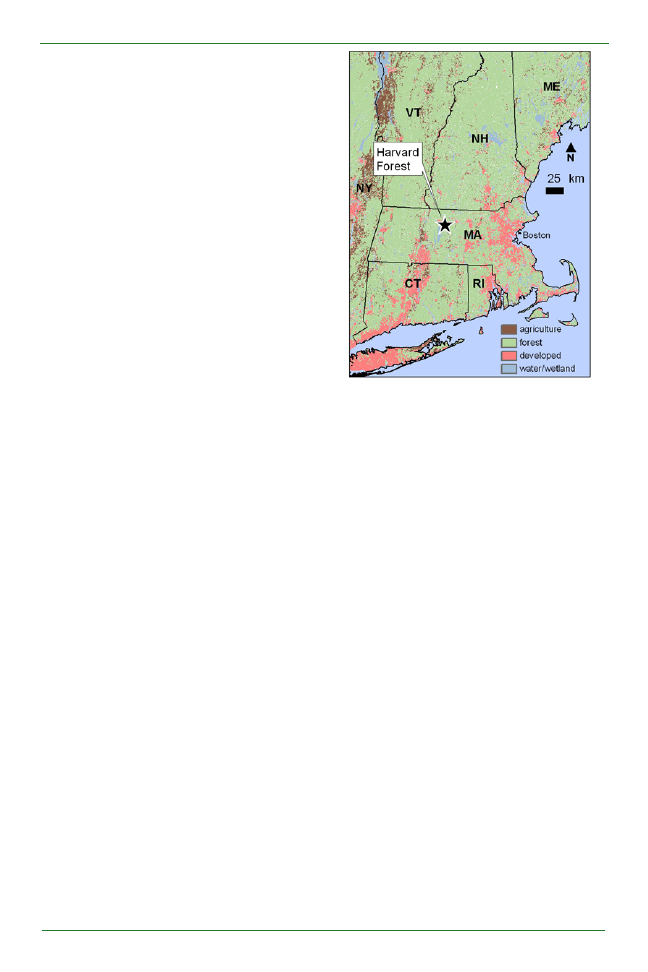
7 8
Plant Science Bulletin 56(2) 2010
The Flowering of Botany at the
Harvard Forest
Audrey Barker Plotkin
1
, Site Coordinator and
P. Barry Tomlinson, Professor Emeritus
Harvard Forest, Harvard University, 324 N.
Main St., Petersham, MA 01366
1
aabarker@fas.harvard.edu
The Harvard Forest is less than 100 miles
(less than a 2-hour drive) from Providence, RI.
The Fisher Museum, featuring twenty-three
internationally acclaimed dioramas portraying
the history, conservation and management of
central New England forests, is open Monday
- Friday 9am - 4pm and Saturday - Sunday
12pm - 4pm from May – October. Self-guided
trails are always open.
Introduction to the Harvard Forest
Located within the New England Upland
physiographic region, the Harvard Forest’s
rolling hills and valleys range from 220m to
410m above sea level. The bedrock underlying
the terrain is a mixture of metamorphic rocks
formed during continental collisions during
the middle Devonian. Local site conditions are
driven by the stony glacial tills deposited during
the Wisconsin ice age. These are interspersed
with local glacial outwash deposits and wetland
peats. Soils are stony and acidic, with a wide
range of depth and moisture. The very few
calcareous or shoreline sites contain a
disproportionate amount of the floral diversity
of the Forest.
Since its establishment in 1907 the Harvard
Forest has served as Harvard University’s
outdoor laboratory and classroom for research
and education in forest biology, ecology, and
conservation. Located 65 miles west of
Cambridge in the rural town of Petersham,
Massachusetts, the land base includes diverse
forests, wetlands and streams, as well as the
70-acre Harvard Pond (Figure 1). From a center
comprising 3500 acres of land, research
facilities, classrooms, residences and the
Fisher Museum (Foster and O’Keefe 2000),
the scientists, students, and collaborators at
the Forest explore topics ranging from forest
and biodiversity conservation and
environmental change to land-use history and
the ways in which physical, biological and
human systems interact to change our earth.
The climate is cool, moist temperate: July mean
temperature is 68
o
F and the January mean
temperature is 21
o
F. Throughout the region,
winter temperatures have warmed nearly 5
o
F
over the last 40 years, a remarkably rapid
change. The average annual precipitation is
110cm and is distributed fairly evenly throughout
the year as rain and snow. Forest cover
dominates the current landscape. While there
are some quite old trees, the land was largely
cleared for agriculture during the 18
th
and 19
th
centuries (Figure 2). Remaining primary forests
were used as woodlots during the agricultural
period, and remnant old-growth forests were
blown down in the Great 1938 Hurricane.
Historical land-use determines the basic
patterns of vegetation distribution even after
more than 100 years (Motzkin et al. 1999).
The Harvard Forest Long Term Ecological
Research Program (NSF) has served as a
foundation for integrated, long-term studies of
forest dynamics since 1988. Beginning this
Figure 1. Harvard Forest’s location in New England
(Map: B.R. Hall).
Reports and Reviews
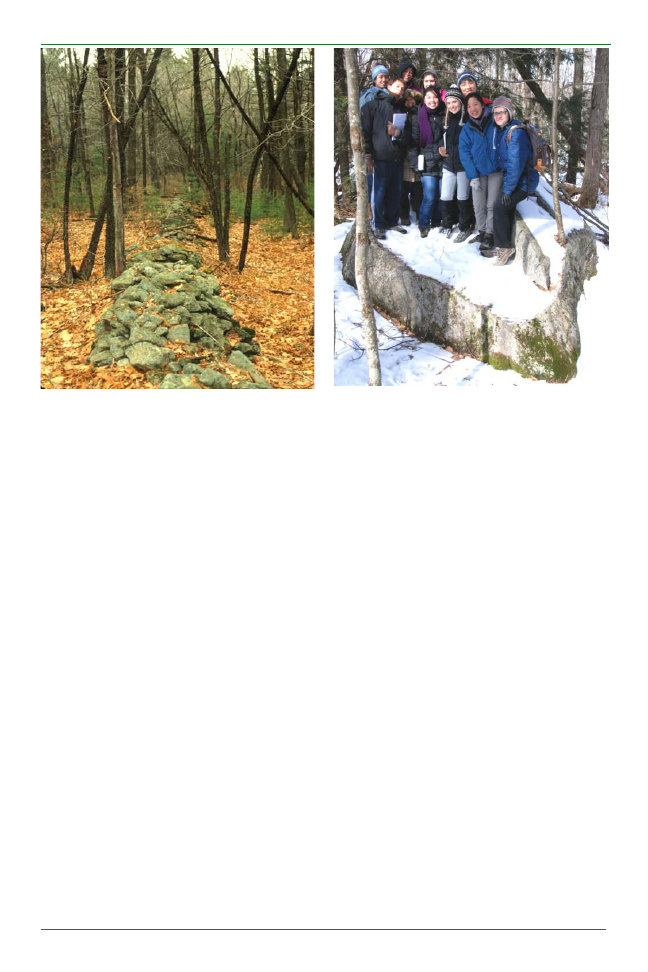
7 9
Plant Science Bulletin 56(2) 2010
year, the National Ecological Observatory
Network (NSF) is initiating research at Harvard
Forest as part of its continental-scale network
of ecological observatory sites. The Harvard
Forest is a department within the Faculty of Arts
and Sciences of Harvard University and
administers the Graduate Program in Forestry
and a Summer Research Program in Ecology.
The Forest has extensive field research
infrastructure including three eddy flux towers,
two walk-up towers, a mobile canopy lift, a
meteorological station, two gauged low-order
watersheds, numerous long-term
experimental plots, and paleoecological,
historical and permanent plot studies. Twelve
buildings (70,000 ft
2
) provide laboratories, an
archive, library, museum, lecture hall for 125,
two classrooms and numerous discussion
rooms, dormitories and single-family housing,
commercial kitchen and a dining room for 100.
The on-site staff of 35, together with >100
collaborating scientists, engage in research
spanning a wide range of the biological,
physical, social, and computer sciences. An
integrated administrative and facilities staff
supports all aspects of research, education
and outreach.
Despite the geographic distance, faculty at the
Forest fulfilled their teaching obligations mainly
in Cambridge so that interaction between them
and both graduate and undergraduate students
was always a priority. Forest staff were early
adopters of Harvard’s innovative Freshman
Seminar program, which has been conducted
for nearly 30 years (Figure 3). The course runs
over four weekends at Harvard Forest,
introducing basic concepts of forest biology to
generations of first-year students. The success
of this seminar and recognition of the unique
facilities for field research prompted the
formation of a summer research program in
ecology, instigated by current director David
Foster and now superbly led for more than 25
students annually by Senior Ecologist Aaron
Ellison. The program involves Forest staff and
mentors from collaborating institutions, and
makes full use of the Forest’s accommodations,
laboratories and field facilities.
Botanical Research at the Forest
Through the years, researchers have focused
on forest management, soils and the
development of forest-site concepts, the biology
Figure 2. Second-growth forest with stonewall
legacies of the agricultural past (photo: D.R. Foster)
Figure 3. The 2010 Harvard Forest Freshman Seminar
class. The course title this year is “Global Change
Ecology – Forests, Ecosystem Function, and the
Future” (photo: D.R. Foster)
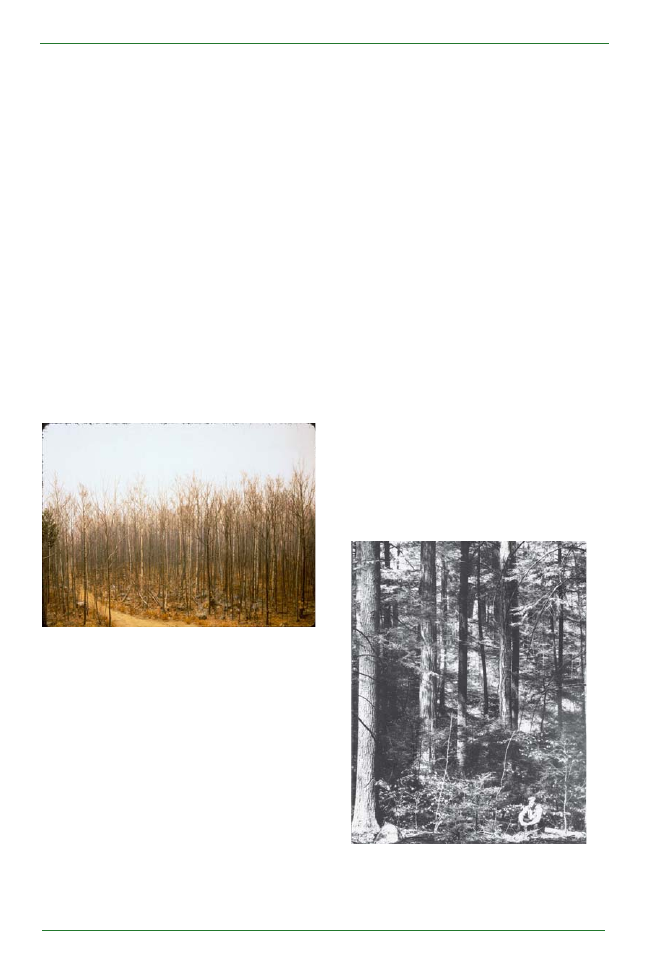
8 0
Plant Science Bulletin 56(2) 2010
of temperate and tropical trees, plant ecology,
forest economics, landscape history,
conservation biology, and ecosystem
dynamics. Historically, we may recognize three
periods, each with a different emphasis: first,
the establishment of an understanding of the
nature of the forests themselves as exemplars
of forest dynamics in New England, which
coincided with a lengthy period of active forest
management and research in silviculture;
second, a period when research was funded
extensively by the Maria Moors Cabot
Foundation during which a diversity of botanical
projects were supported; and third, the current
period when the Harvard Forest returned to its
strong integration of field, laboratory and
theoretical studies and became part of the
Long-Term Ecological Research program
funded by the National Science Foundation
with the main focus on the ecological dynamics
of the vegetation and land-use at the Forest
and throughout New England. Throughout the
various programs researchers at the Forest
and beyond have maintained a strongly
collaborative approach, which is a hallmark of
the scientific community in Petersham.
Establishment of the Forest, 1907-1937
The early years saw the establishment of
extensive experimental forest plantations and
the development of mixed-species silviculture
(Figure 4), notably by R.T. Fisher, who served
as the Harvard Forest’s first director from 1907-
1934, and his student and third director Albert
C. Cline. Demonstration of sustained yield
forestry was a primary focus, supported by
many studies of silvics and soils. Most
publications from this era focused on the growth
and site relations of commercial timber
species, with some work conducted on wood
anatomy by Irving Bailey, who earned the Master
of Forestry at Harvard in 1909 and then served
on the Harvard faculty (e.g., Bailey 1910).
The first records of the woody plants at Harvard
Forest were collected by John George Jack and
his students in 1908. Jack was an assistant
professor of dendrology at the Arnold Arboretum,
and published his findings in the 1911 Bulletin
of the Harvard Forestry Club.
The Blossoming of Botanical Research, 1937-
1987
As a consequence of efforts by Fisher’s
successor, Ward Shepard and botanical
administrator Edwin D. Merrill, the Maria Moors
Cabot Foundation for Botanical Research was
established at Harvard University in 1937 with
funding from Godfrey L. Cabot, a Boston
industrialist. For fifty years, this foundation would
provide steady support for a wide range of
research at Harvard’s botanical institutes,
including the Harvard Forest. Dr. Cabot, the
benefactor, was particularly interested in
enhancing the productivity of trees, with a
Figure 4. Fisher Museum diorama depicting the first
thinning of a mixed-hardwood forest, ca. 1930.
Figure 5. This 1910s photo of the old-growth Pisgah
tract appeared in Merrill’s announcement of the Cabot
Foundation in Scientific Monthly. The forest was
destroyed one year later by the Great Hurricane of
1938 (photo: Harvard Forest Archives)
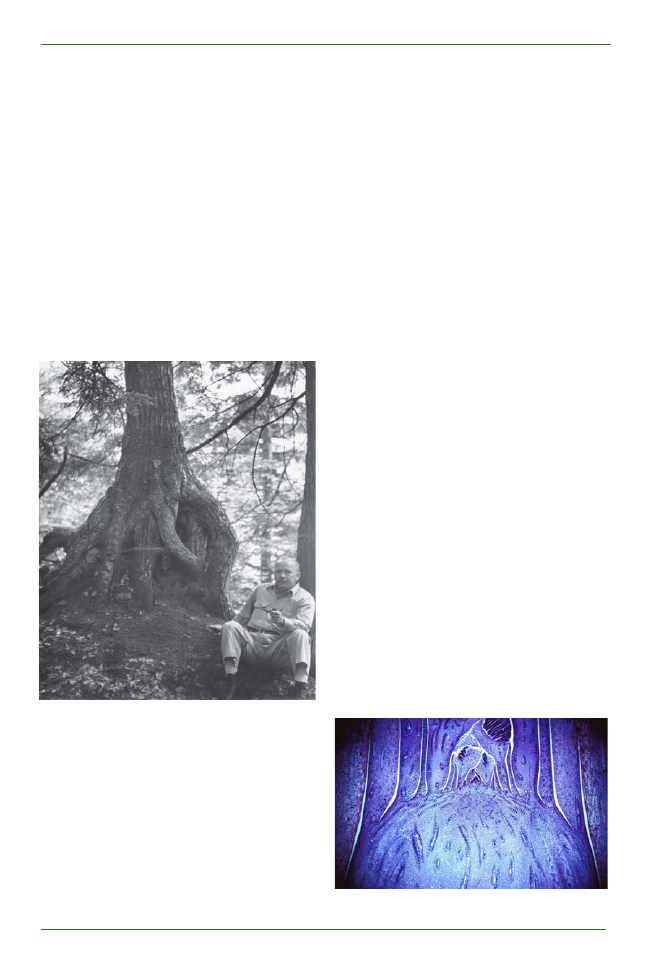
8 1
Plant Science Bulletin 56(2) 2010
rationale that sounds quite modern: to better
utilize the energy embodied in living plants
so that we might be less dependent on
fossilized plant remains (fossil fuels).
Professor Merrill’s announcement of the
foundation in The Scientific Monthly (Merrill
1937) featured several photos of forest types
and experiments at the Harvard Forest (Figure
5).
The botanist Hugh M. Raup came to the
Harvard Forest in 1937 and served as director
from 1946-1967. He made many fine
botanical collections that were
complemented by his wife Lucy’s collections
of lichens and bryophytes and produced a
Checklist of the Vascular Plants of
Petersham, but much of his botanical work
was in the Arctic. His broad-minded
understanding of the ecology, geography,
botany and history of the Arctic and New England
led to his challenge to stable-state
successional theory with his counter-message
of change, unpredictability of natural and human
systems, and ecosystem resilience (Figure 6).
Later, in association with the newly established
Department of Organismic and Evolutionary
Biology at Harvard, academic horizons were
broadened when as many as five faculty made
Harvard Forest their home. Notably they laid
emphasis on the purpose of the Cabot
Foundation, which was to support research on
trees and communicate this knowledge widely.
The scholarly presence always focused on
interactions among different researchers, a
well-sustained tradition with all Forest visitors.
Martin Zimmerman, who was brought to the
Forest in 1954 by Professor Raup and became
Harvard Forest Director in 1969, had an
insightful ability to combine structure with
function that led to a better understanding of
long distance transport in woody plants
(Zimmerman 1971, 1983). His reach extended
well beyond the Forest itself. For example, he
made fundamental discoveries about the
anatomy of palm trees that could be translated
back to more conventional trees.
John G. Torrey chose to move his research
from Cambridge to Petersham in order to build
state-of-the-art laboratories and greenhouse
facilities that made possible the study of plants
outside their natural habitat in order to explore
the development and physiology of roots (Torrey
and Clarkson 1975). His work on the symbiotic
relations between trees and microbial
organisms bridged the interface between
physiology and ecology (Torrey 1978). Peter
DelTredici, now Lecturer in the Department of
Landscape Architecture and Senior Research
Scientist at the Arnold Arboretum, assisted this
research during the 1970s.
On his appointment at Harvard in 1971, Barry
Tomlinson chose to be located in Petersham
so as to continue a long-established research
association with Martin Zimmerman. He
brought an international perspective to the study
Figure 6. Hugh Raup holds court next to a birch
growing on top of a treefall mound (photo: Harvard
Forest Archives).
Figure 7. The palm Rhapis excelsa L.S. crown
(photo: P.B. Tomlinson)
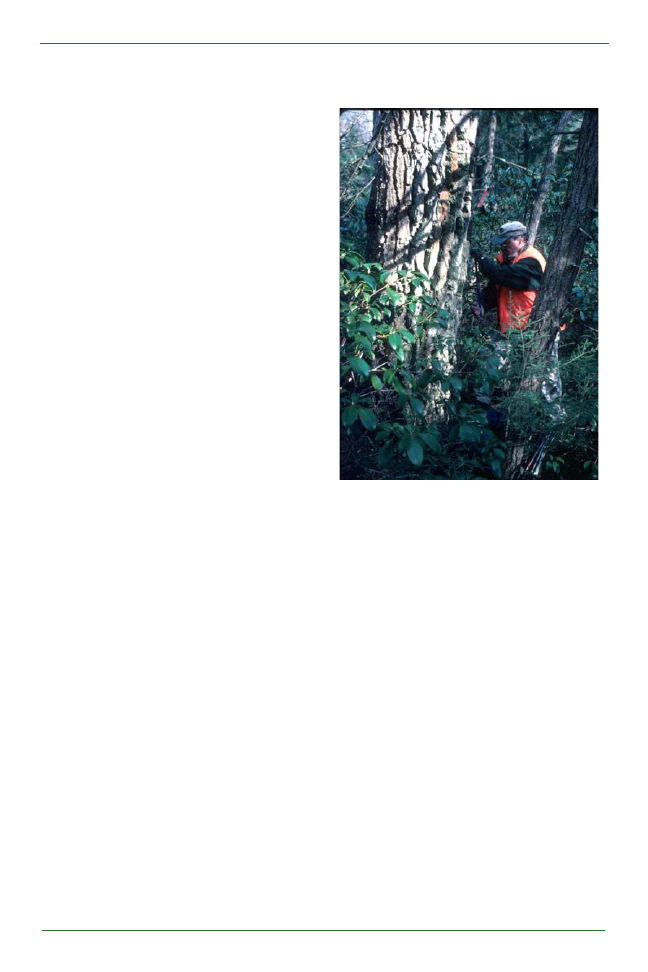
8 2
Plant Science Bulletin 56(2) 2010
of trees and other plants relating to prior
experience in the tropics and subtropics. In
retirement he still uses Forest facilities and
has recently updated an early study of palm
anatomy in collaboration with Jack B. Fisher
and J.W. Horn (Figure 7).
Botanical Research in an Ecological Context,
1988-Present
As the Cabot funding era came to a close, John
Torrey was instrumental in positioning Harvard
Forest to become an NSF-funded Long-Term
Ecological Research Site. Since then, botany
has been explicitly tied to conservation (Foster
et al. 2005) and ecology and engages many
faculty including Richard Forman from the
Graduate School of Design, Steve Wofsy from
Earth and Planetary Sciences, Paul Moorcroft,
Andrew Richardson and Anne Pringle from
Biology. Plant population dynamics, scaling
leaf-level physiology to whole-forest function,
studying how plants become invasives, and
documenting physiological response to
climate change are all examples of botanical
research in an ecological context (Foster and
Aber 2004). The students of Fakhri Bazzaz
conducted work in many sites including the
Harvard Forest, linking plant allocation,
competition, and genetic strategies, with the
field of global change biology. A former post-
doc, Kristina Stinson is a now plant population
ecologist at the Forest, and her current studies
include population-to-landscape studies of
invasive plants and the mechanisms of
increased ragweed pollen production in
response to climate change.
Research on long-distance transport of water
in trees by Missy Holbrook at the Harvard
Forest informs long-term monitoring of carbon
and water exchange between the forest and
the atmosphere and extends the research
legacy of Zimmerman. Twenty years of
phenology monitoring of tree leaf-out by Dr.
John O’Keefe complements a new phenology
web-cam at the Forest that is part of a regional
phenology network.
This year, the Harvard Forest is installing a 35-
hectare Forest Dynamics Plot in which all
woody stems >1cm will be censused every five
years, allowing detailed understating of tree
demographics in this temperate forest and
comparisons to the Center for Tropical Forest
Science network of tropical and temperate plots
throughout the world. In addition, David Orwig
conducts detailed dendroecology research on
problems including tree response to invasive
pests such as the Asian Long-horned beetle
and developing a better understanding of the
dynamics of the pockets of old-growth forest
that remain in Massachusetts (Figure 8).
Aaron Ellison uses the northern pitcher plant,
Sarracenia purpurea, to study the dynamics of
food webs. The inquiline foodwebs within the
water-filled pitchers of Sarracenia are a model
system for community ecology work. At the
other end of the temporal spectrum, current
Forest director David Foster maintains a
paleoecology laboratory in which he and others
investigate the assembly of vegetation
communities over hundreds to thousands of
years.
A Centennial Flora
A complete update and analysis of the vascular
flora of Harvard Forest was conducted by Jerry
Figure 8. Coring a 400-500 year-old black gum
(Nyssa sylvatica) near the Harvard Forest (photo:
D.R. Foster)
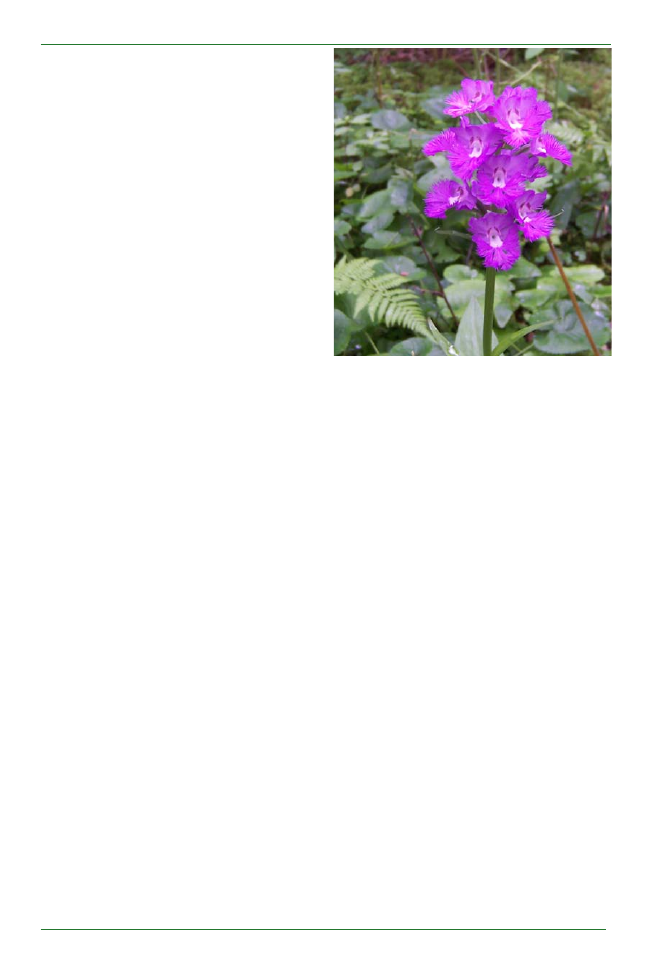
8 3
Plant Science Bulletin 56(2) 2010
Jenkins, Glenn Motzkin and Kirsten Ward from
2004-2007. This is an elegant, thoughtful work
that includes comparisons to previous floras
and an analysis of change over the past 100
years. The work is explicitly embedded in an
ecological context:
“Harvard Forest is an ecological research
station, and our goal in the centennial flora
project was to provide an ecological description
of the flora. To us this meant that we had to both
enumerate the species that were present and
describe what they were doing. . . our guiding
principle was that plant populations are
ecologically interesting entities in a way that
individual plants are not. A few stems of a rare
species, seen once in one place, are an
interesting botanical detail but provide little
ecological information. A group of occurrence
of the same species starts to have an ecological
shape; a group of occurrences with a habitat
and a history have a story to tell.” (Jenkins et al.
2008, p.21)
In addition to lively species accounts and an
extensive discussion of the taxonomy of “badly
behaved species,” the Flora provides an
analysis of how site, land-use change, climate
change and natural disturbance influenced
changes over four surveys since 1911. Despite
a dynamic century, the native flora has been
remarkably stable. The number of alien species
has increased, but they have not (yet) made
many inroads into the intact second-growth
forests.
Conclusion
Investigating the lives of plants will continue as
the Harvard Forest settles into its second
century, and we look forward to the surprises
that await discovery. Here is but one small
example. The first author (a forester by training,
so no crack botanist) observed purple fringed
orchid in 2008, a species never-before recorded
at the Harvard Forest. Glenn Motzkin identified
the species as Platanthera grandiflora, the
greater purple fringed orchid (Figure 9). While
its congener, the lesser purple fringed orchid
(Platanthera psycodes) was observed
elsewhere on the Forest in 1933 and 1947, this
species is a new addition to the flora. After even
the most careful botanical survey and a century
of intensive research, the woods reveal new
and lovely surprises.
Literature Cited
Bailey, I. W. 1910. Notes on the Wood Structure
of the Betulaceae and Fagaceae. Forestry
Quarterly 8: 178-185.
Foster, D. R. and J.D. Aber (eds.) 2004. Forests
in Time: The Environmental Consequences of
1000 Years of Change in New England. Yale
University Press, New Haven, CT.
Foster, D. R., Kittredge, D. B., Donahue, B.,
Motzkin, G., Orwig, D. A., Ellison, A. M., Hall, B.,
Colburn, E. A., D’Amato, A. 2005. Wildlands
and Woodlands: A Vision for the Forests of
Massachusetts. Harvard Forest Paper 27: 25.
Foster, D. R. and J. O’Keefe. 2000. New England
Forests Through Time: Insights from the
Harvard Forest Dioramas. Harvard Forest and
Harvard University Press, Petersham and
Cambridge.
Jack, J. G. 1911. Trees and other woody plants
found in the Harvard Forest, 1908-09. Harvard
Figure 9. Large purple-fringed orchid (photo: A.
Barker Plotkin)
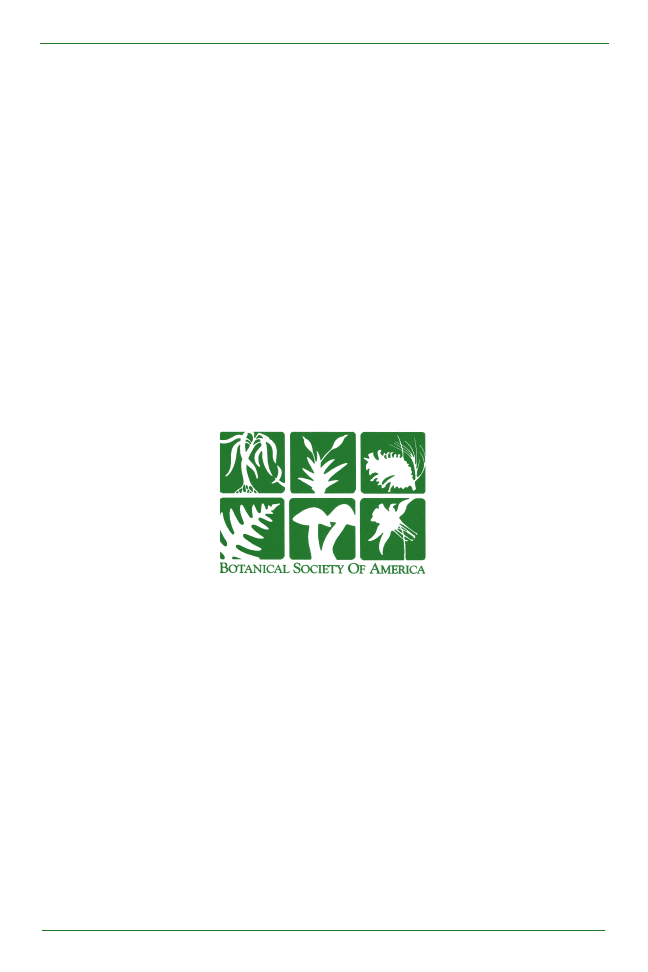
8 4
Plant Science Bulletin 56(2) 2010
Forestry Club Bulletin 1: 10-26.
Jenkins, J. C., G. Motzkin, and K. Ward. 2008.
The Harvard Forest Flora. An Inventory, Analysis
and Ecological History. Harvard Forest Paper
28: 266 pages.
Merrill, E.D. 1937. The Maria Moors Cabot
Foundation for Botanical Research at Harvard
University. The Scientific Monthly 45:277-281.
Motzkin, G., Wilson, P., Foster, D. R., Allen, A. E.
1999. Vegetation patterns in heterogeneous
landscapes: the importance of history and
environment. Journal of Vegetation Science
10: 903-920.
Tomlinson, P.B., J.W. Horn and J.B. Fisher.
Forthcoming. The Anatomy of Palms. Oxford
University Press.
Ecology
Seed Dispersal by Bats in the Neotropics. Lobova, Tatyana A., Cullen K. Geiselman, and Scott
A. Mori.-
-
Marcel Rejmánek.
...................................................................................................................85
Economic Botany
Botanicals: Environmental Expressions in Art. The Alisa and Isaac M. Sutton Collection--
Douglas Darnowski..............................................................................................................................86
Chinese and Related North American Herbs. Phytopharmacology and Therapeutic Values.
Second Edition. Li, Thomas S.C.--Tadeusz Aniszewski.................................................................87
The Fruit Hunters: A Story of Nature, Adventure, Commerce and Obsession. Gollner, Adam
Leith.--Douglas Darnowski...................................................................................................................88
Seed to Elegance: Kentia Palms of Norfolk Island, South Pacific. Williams, Kevin.--Tony
Bedell........................................................................................................................................................89
Torrey, J. G. 1978. Nitrogen fixation by
actinomycete-nodulated angiosperms.
Bioscience 28: 586-592.
Torrey, J. G. 1994. History of the Maria Moors
Cabot Foundation for Botanical Research 1937-
1987. Harvard University.
Torrey, J.G and D. T. Clarkson, eds. 1975. The
Development and Function of Roots. London:
Academic Press.
Zimmermann, M. H., Brown, C. L. 1971. Trees:
Structure and Function. Springer-Verlag, New
York-Heidelberg-Berlin,
Zimmermann, M. H. 1983. Xylem structure and
the ascent of sap. Springer-Verlag, Berlin,
Heidelberg, Tokyo, New York
Books Reviewed

8 5
Plant Science Bulletin 56(2) 2010
Seed Dispersal by Bats in the Neotropics.
Lobova, Tatyana A., Cullen K. Geiselman, and
Scott A. Mori. 2009. ISBN-13 978-089327-501-
3, ISBN-10 0-89327-501-8 (Cloth US$70.00)
xiii + 471 pp. Memoires of the New York Botanical
Garden, Vol. 101, The New York Botanical
Garden Press, Bronx, New York.
Bats are important seed dispersal vectors in
all tropical forests. They play a key role in tree
regeneration and forest succession (Kelm et
al., 2008; Melo et al., 2009). Some bat species
can fly 30 to over 300 km in one night and
therefore are, besides birds, the most
important long-distance small seed dispersal
agents (Mendes et al., 2009; Richter &
Cumming, 2008). This new volume, Seed
Dispersal by Bats in the Neotropics, is based
on the original research in forests of central
French Guiana. However, it is also the first
synthetic treatment of frugivorous bats–plant
interactions in the Neotropical region as a
whole.
The volume begins with Introduction,
summarizing what is known about Neotropical
plant diversity, forest regeneration, bat diversity,
bat–plant interactions, characteristics of bat-
dispersed plants, and the effectiveness of bats
as seed dispersal agents. The study area, field
methods, and terminology used in the book are
described in Materials and Methods. The body
of the text is divided into two main parts: Bat-
Dispersed Plants and Frugivorous Bats. Here
the lists of known bat-dispersed plant species
and their characteristics are analyzed and
feeding habits of frugivorous bat species are
reviewed. Following the main text, there are
four appendices that include (I) a list of plant
species diasporas collected from bats during
the field observations and experiments in
central French Guiana, (II) a list of plants with
the bat species that disperse their diaspores
in the Neotropics, (III) a list of frugivorous bat
species along with the plants they disperse in
the Neotropics, and (IV) a glossary of botanical
terms used in this volume.
Genetics
Principles and Practices of Plant Genomics, Volume 2: Molecular Breeding. Kole, Chittaranjan
and Albert G. Abbott, Eds.--Lindsey K. Tuominen..............................................................................89
Mycology
Biodiversity and Ecology of Lichens. Aptroot, A, M. R. D. Seaward & L. B. Sparrius (eds).-- William
B. Sanders...............................................................................................................................................90
Lichen Biology, 2
nd
ed. Nash, Thomas H. III (ed).--Douglas Darnowski.....................................91
Development and Structure
Araucariaceae: Proceedings of the 2002 Araucariaceae Symposium (Araucaria, Agathis,
Wollemia). Wilcox, M.D. and R.L. Beleski (eds).--P. Barry Tomlinson........................................92
Systematics
Flora de Nicaragua, Tomo IV, Helechos. Luis Diego Gómez y Alba L. Arbeláez.--Marcel
Rejmánek.................................................................................................................................................93
A Flora of the Liverworts and Hornworts of New Zealand. Volume 1. Engle, John L.l and David
Glenny.--Jennifer Tate............................................................................................................................94
Genera Orchidacearum. Volume 5. Epidendroideae (Part 2). Pridgeon, Alec M., Phillp J. Cribb,
Mark W. Chase, and Finn N. Rasmussen, editors.--William Louis Stern...................................95
The Vegetation of Egypt. Zahran, M.A., Willis, A.J.--Dorothea Bedigian......................................96

8 6
Plant Science Bulletin 56(2) 2010
Botanicals: Environmental Expressions in Art.
The Alisa and Isaac M. Sutton Collection.
White, James J. and Lugene B. Bruno. 2009.
ISBN 978-0-913196-83-0 (Paper US$35.00)
133 pp. Hunt Institute for Botanical
Documentation, 5th Floor, Hunt Library,
Carnegie Mellon University, 4909 Frew Street,
Pittsburgh, PA 15213-3890.
Botanicals Environmental Expressions in Art
The Alisa and Isaac M. Sutton Collection
presents another exhibition from the Hunt
Institute for Botanical Documentation at
Carnegie Mellon University, arguably the
world’s finest organization dedicated to
botanical art and related topics. This work
commemorates the exhibition of a private
collection by a couple whose lives have led
them from the Middle East to New York, and by
extension via business travel, throughout the
world. At least in part, the collection was driven,
as Isaac Sutton describes succinctly in two
pages, by a desire to connect to nature while
living in an urban setting, The collection also
clearly shows, based on the plants depicted,
the connection of the collectors to both North
America and the Middle East.
Overall, the most obvious features of the
collection are the heightened realism and bold
colors of most of the works. True, there are a few
highly stylized items (e.g. pp. 20-21) and some
works with more muted tones (lichens, pp. 74-
75), but most works reproduced tend towards
the brillance of Symplenia globalifera and Rosa
According to this monograph, 549 plant
species, belonging to 191 genera and 62
families, have been found to be dispersed by
bats in the Neotropics. However, this number
is certainly very conservative because it includes
only published reports and results of authors’
field studies up until October 2006. More recent
records are available through the online
Database of Neotropical Bat-Plant Interactions
(
http://www.nybg.org/botany/tlobova/mori/
batsplants/database/dbase_frameset.html
).
In central French Guiana, at least 15% of the
native angiosperm species and 29% of those
bearing fleshy fruits may rely on bats to disperse
their seeds. The majority of these plants (77%)
are endozoochorously dispersed and possess
small diaspores (<8 mm), whereas 22% are
stomatochorously dispersed species with
larger seeds, stones, or pyrenes. Main plant
families with bat-dispersed seeds are
Piperaceae, Solanaceae, Moraceae, Araceae,
Clusiaceae, Cyclanthaceae,
Melastomataceae, Anacardiaceae,
Marcgraviaceae, and Chrysobalanaceae.
Descriptions of 112 bat-dispersed species
are complemented by excellent color
photographs of their fruits and seeds. Besides
detailed species descriptions, the authors
analyze the diverse traits of bat-dispersed
plants to reexamine a phenomenon known as
the “bat-fruit syndrome.” Moreover,
descriptions of the foraging ecology and
feeding behavior of the 37 fruit-eating bat
species found in central French Guiana are
presented in a separate chapter. Over 350
references from the period 1910–2007 serve
as additional sources of information.
The book summarizes decades of research
from many parts of the Neotropics. It will
definitely provide a stimulus for further
ecological and evolutionary studies on bat–
plant interactions. Because there aren’t any
publications of this kind covering the Old World
tropics, I am sure that this volume will serve as
a model for similar syntheses from other
tropical areas.
-Marcel Rejmánek, Department of Evolution and
Ecology, University of California, Davis, CA 95616
Literature Cited
Kelm, D. H., K. R. Wiesner & O. von Helversen. 2008.
Effects of artificial roosts for frugivorous bats on
seed dispersal in a Neotropical forest pasture mosaic.
Conservation Biology 22: 733-741.
Melo, F. P. L., B. Rodriguez-Herrera, R. Chazdon, R.
A. Medellin & G. G. Ceballos. 2009. Small tent-roosting
bats promote dispersal of large-seeded plants in a
Neotropical forest. Biotropica 41: 737-743.
Mendes, P., T.B. Vieira, M. Oprea & A. D. Ditchfield.
2009. Long-distance movement of Artibeus lituratus
(Chiroptera: Phyllostomidae) in the state of Espírto
Santo, Brazil. Ecotropica 15: 43-46.
Richter, H. V. & G. S. Cumming. 2008. First application
of satellite telemetry to track African straw-colored
fruit bat migration. Journal of Zoology 275: 172-176.

8 7
Plant Science Bulletin 56(2) 2010
Chinese and Related North American Herbs.
Phytopharmacology and Therapeutic Values.
Second Edition. Li, Thomas S.C. CRC Press
Taylor & Francis Group. Boca Raton, London
and New York. 705 pp.
This is a large book with large aspirations as
it seeks to describe similarities and differences
between medicinal species used in China and
in North America. The idea of the book is
challenging and it has some importance for
the development of the use of plants in both
alternative medicine and as a potential source
for industrial product development. However,
the book holds big surprises for the reader. Of
its 705 pages only 4 are text pages proper,
while the remainder consist of tables, literature,
appendices and indices. The book is a
compilation of the data on the subject published
in the literature in English and presented
schematically and without analysis. Although
in the Foreword to the book Ernest Small, PhD,
states that the book is a work of genius and a
superb and invaluable synthesis, a detailed
reading of the content may lead one to dispute
this view from the standpoint of formal scientific
evidence, botany and chemistry, and from that
of existing and potential applications.
Nevertheless, the book can be read in a critical
spirit by botanists and other specialists.
However, the book is a result of a large research
compilation effort and has a value for the
beginners in the subject and as an introduction
to Chinese traditional uses of herbs, and to the
alternative use of medicines of herbal origin
globally. These topics of applied botany are
interesting and the second edition of the book
testifies to present day interest in past herbal
cures, especially in cases when scientific
pharmaceutical achievements are unable to
provide remedies for new serious diseases
and other problems. The new high technology
development of medicines is also interested in
working with both Eastern and Western
experience of herbal medicine. Alkaloids as
the products of plants and other organisms
have been and continue to be a basis for
development of new synthetic medicines. The
potential use of virus-lines in the treatment of
brain cancer is a good example of the
development of high-tech medicine utilizing
natural mechanisms. As plant species are
distributed around the world so also has been
their use. Therefore, traditional Chinese
medicine can be not analyzed without taking
into account both global and local aspects.
The best and most value parts of the content in
the book are the names of plants in three
languages (Latin and common names in
Chinese and English) and the lists of the major
constituents of plants taken from the literature
(p. 4 - 173). However, on the same pages the
“therapeutic values” are not sourced from the
literature and are very general. The annotation
that this information should not be used for
diagnostic purposes adds to the vagueness of
these values. Moreover, close reading of the
book yields both useful material and also some
confusions. For example, on page 79 it is
mentioned in the case of Hyoscyamus
bohemicus that major constituents in the root
are “alkaloid, hyoscyamine, hyoscine,
scopolamine... “. Alkaloid is only the name of
group of compounds and hyoscyamine as well
as hyoscine or scopolamine are simply
alkaloids. On pages 175-304 the author
compares the major constituents of plants in
China and similar species in North America.
As the information is drawn from different
sources, the comparison of the constituents is
controversial and imprecise and at odds with
the scientific methodology. The literature cited
covers 621 items, which represents only a very
small part of the literature published in the year
2000 or later. The rest of the book contains
repetitions put in the form of appendices and
indices. Summa summarum: an interesting
and useful book of a general and thesaurus-
like character with some controversial aspects.
It should therefore be read carefully and critically
as risk regarding its content is laid at the door
of the reader.
Prof. Dr. Tadeusz Aniszewski
University of Eastern Finland
roxburghii ‘Plena’ (pp. 90-91 and 104-105,
respectively). Most of originals are watercolor
on paper, but there are a noticeable fraction
done on vellum. Enthusiasts of botanical art
and illustration will enjoy this very attractive
collection.
-Douglas Darnowski, Department of Biology,
Indiana University Southeast.

8 8
Plant Science Bulletin 56(2) 2010
Seed to Elegance: Kentia Palms of Norfolk
Island, South Pacific. Williams, Kevin. 2008.
ISBN 978-0-9775121-1-9 (Paper US$24.95)
72 pp. Studio Monarch Books, PO Box 534,
Norfolk Island 2899, South Pacific.
In Seed to Elegance: Kentia Palms of Norfolk
Island, South Pacific by Kevin Williams, we are
treated to a brief history of the economic
importance and commercial industry of kentia
palms. The “queen of palms” is given a glowing
historical account spanning several centuries.
With its dozens of photographs and easy-to-
read print, Seed to Elegance offers its readers
a jumping off place into the realm of kentia
palms.
Although being reviewed for Plant Science
Bulletin, this book offers little of the lifecycle,
habits, and growing patterns of kentia palms
in the wild or commercial production. In over 60
pages of text, the botanical name Howea
fosteriana is not mentioned once. If one were
looking for a detailed botanical account of H.
fosteriana, this would not be the place.
On the other hand, Seed to Elegance provides
an enriching and lively account of the settlement
of Norfolk Island in the South Pacific. From its
initial discovery by Captain James Cook to
penal colonies to the booming kentia seed
and seedling export industry, this book takes
the reader on a fascinating journey. From island
native to aristocratic décor, kentias have
secured their place in modern horticulture.
Seed to Elegance is a great read for anyone
wishing to purchase a kentia for their home or
office. The compelling text and glossy photos
make the book accessible to anyone looking
for an introduction into the world of kentia
palms. Unfortunately, the book’s claim that it
“explains all” is a far cry from the truth, leaving
the reviewer feeling as though he had just read
an oversized sales pamphlet about kentias.
-Tony Bedell, 606 Alpine Ave, Boulder, CO
80304
The Fruit Hunters: A Story of Nature,
Adventure, Commerce and Obsession.
Gollner, Adam Leith. 2008. ISBN 978-0-7432-
9694-6 (Cloth US$25.00) 279 pp. Scribner,
1230 Avenue of the Americas, New York, NY
10020.
The Fruit Hunters by Adam Leith Gollner is a
tremendously disappointing work. It’s title
brings to mind the exotic fruits and fruit tastings
which can make teaching botany so much fun.
And it does successfully aim to present lots of
information on exotic fruits. However, there are
quite a few major problems.
Gollner does do a good job of describing many
fruits not commonly eaten in North America
(the author is Canadian), and he discusses
the ethnobotany of fruit at some length. He also
touches on topics like illegal importation of
rare fruits and rare cultivars of commoner
fruits, the history of miracle berry, and fruitarians
(those who only eat fruit). He extolls the need
to preserve rare and exotic species and to
broaden t he taxonomic base of our diets. All
good.
He misses some obvious organizations to be
brought up in such a work. Although he provides
a whole chapter on the Rare Fruit Council
International, based in Florida, the other large,
active amateur society in North America which
is dedicated to underutilized fruits, the California
Rare Fruit Growers, flies under Gollner’s radar.
And then there is his seeming obsession with
sex. OK, fruit is a product of botanical sex, we
get it. Linnaeus wasn’t a poster boy for charity,
check. But does the author need to inject sex
over, and over, and over. A lengthy and detailed
description of how the coco-de-mer’s fruit and
flowers resemble human genitalia and
erogenous zones in various stages of sexual
activity is one of the less offensive examples.
There are a wide range of books and other
works on exotic fruit which are better written
and suitable for any age of reader (see the
websites of the California Rare Fruit Growers
and the Rare Fruit Council International for
examples and recommendations).
-Douglas Darnowski, Department of Biology, Indiana
Univesity Southeast, New Albany, IN 47150.

8 9
Plant Science Bulletin 56(2) 2010
Principles and Practices of Plant Genomics,
Volume 2: Molecular Breeding. Kole,
Chittaranjan and Albert G. Abbott, Eds. 2008.
ISBN 978-1-578-08537-8 (Hardcover
US$129.95) 502 pp. Science Publishers, Inc.,
234 May Street, Post Office Box 699, Enfield,
New Hampshire 03748.
Genomics is a rapidly expanding set of
methodologies for the study of organismal
function, evolution, and even ecology based on
the information contained in a plant’s full
complement of genetic material. Chittaranjan
and Abbott have compiled a three-volume
series devoted to the topic of plant genomics
which is divided approximately according to
the history of the technological developments
in the field. The first volume is devoted to
genome mapping, the second volume focuses
on molecular breeding, and the third describes
advanced genomics technologies, overall
promising thorough coverage of the field as a
whole.
In reviewing Volume 2 of this series, I closely
read six of the thirteen chapters and skimmed
the remaining seven to get a feel for the scope
of the material covered. The organization of the
volume broadly encompasses a set of chapters
on molecular breeding based on the biological
goals of breeding, a second set dealing with
the opportunities and challenges of molecular
breeding in particular types of plants, and a
third set of chapters that were not easily
categorized. This organization had a tendency
to generate redundancies in the material
covered in the book as a whole, but has the
advantage of offering chapters focused on
specific needs. As a result, most people using
this book would probably only need to read one
or two chapters to get a good feel for the
approaches and current status of molecular
breeding as they pertain to a specific crop or
type of stress.
The introductory chapter outlines the complexity
of the field of molecular breeding. As a doctoral
student who is involved with some of the newer
genomics technologies such as the use of
microarrays for candidate gene discovery, I
was interested to learn about the strong
foundation upon which my area of research
has been built. Nonetheless, even with my
background I felt that access to the first volume
of the series would have helped me out in
understanding some of the specific procedural
details of how, for example, molecular markers
are designed. In other words, Volume 2 may
not stand well on its own for someone unfamiliar
with the basics of molecular breeding.
The next six chapters each discuss different
possible goals for the use of molecular marker
use and/or molecular breeding, ranging from
germplasm conservation to improving abiotic
and biotic stress resistance. These chapters
lean toward the “applied science” end of the
research spectrum; for example, the chapter
on biotic stress resistance has a strong focus
on practical considerations necessary for
marker-assisted selection studies conducted
in an industrial context. I enjoyed getting a rare
glimpse into the corporate ag-biotech mindset,
and would recommend that students of
molecular breeding who have not worked
outside of academia read this chapter if they
are considering working in industry.
The following four chapters focus on molecular
mapping and breeding in fruit trees, forest
trees, polyploids, and forage and turf plants,
respectively. Since I am involved in research on
forest trees, I closely read the chapter devoted
to this set of plants. It approached the topic
quite comprehensively, outlining the difficulties
of molecular mapping and breeding in forest
trees and then discussing the innovative ways
in which such difficulties have been turned into
advantages by creative researchers. Although
the other three chapters are not nearly as
thorough, they are still similar in that a major
focus is given to the innovations that have been
necessary for breeding these trickier crops
which, due in part to their biological peculiarities,
have been somewhat left on the margins of
molecular research.
The last two chapters of the volume are not so
easily categorized, but they are critical to the
main thrust of the volume, focusing on the use
of transgenics for genetic improvement and on
intellectual property rights. The former chapter
gives an overview on what technologies are
available to generate transgenics, how they are
used, and also briefly discusses transgenic
risk assessment, a growing area of research
unto itself. The final chapter on intellectual
property rights provides a critical resource on a

9 0
Plant Science Bulletin 56(2) 2010
Biodiversity and Ecology of Lichens. Aptroot,
A, M. R. D. Seaward & L. B. Sparrius (eds).
Liber Amicorum Harrie SipmanBibliotheca
Lichenologica, vol. 99 (2009). 439 pp. J.
Cramer / Gebrüder Borntraeger, Berlin.
This recent collected volume in the Bibliotheca
Lichenologica series includes twenty-nine
miscellaneous contributions mainly in the
systematics, taxonomy and floristics of lichen
fungi (and lichenicolous fungi). The collection
has been assembled as a Festschrift dedicated
to the Dutch lichenologist H. J. M. “Harrie”
Sipman on the occasion of his 64th birthday
and final year before retirement from his
scientific position in Berlin. The first editor,
André Aptroot, is also author or co-author of
eight of the 29 included papers. He leads off
the volume with a lively, illustrated account of
Harrie Sipman’s career and scientific
adventures. However, the name of the institution
where Dr. Sipman has spent so many
productive years and the title of his position are
nowhere stated, an odd and unfortunate
omission in the career sketch. A chronologically
arranged bibliography of Sipman’s scientific
work — 174 publications — is supplied (also by
Aptroot) at the volume’s end. A list of taxa he has
described — nine genera and 213 species —
is also appended.
The most substantial contribution in the
collection (by Aptroot, Thor, Lücking, Elix and
Chaves) segregates from the genus
Cryptothecia a number of taxa under the
resurrected name Herpothallon. Seventeen
new species are described; a key is provided,
along with detailed character descriptions and
small but excellent color photos of the 29 taxa
encompassed. The reinstated genus
incorporates the well-known red-and-green
corticolous crust (dubbed “Christmas lichen”
in Brodo, Sharnoff & Sharnoff) now referred to
as Herpothallon rubrocinctum.
Other biosystematic contributions deal with
new species of Cladonia from the Azores (Ahti
& Aptroot) and from Iceland (Kristinsson & Ahti),
the genus Bacidia in the Canary Islands and
western Europe (Brand, Coppins, van den
Boom & Sérusiaux), a synopsis of
Placopyrenium (Breuss), lichenicolous
Sphaerellothecium and Zwackhiomyces
(Diederich & Zhurbenko), new Xanthoparmelia
from Tasmania (Elix & Kantvilas), Chapsa from
Brazil (Frisch & Kalb) including new species
with vegetative propagules, cryptothalline
species of Lecidea (Hertel), new Caloplaca
from Australia (Kondratyuk, Kärnefelt, Elix &
Thell), a new Micarea from the West Indies
(Sérusiaux & Coppins), a new genus in the
Arthoniaceae (Synarthothelium Sparrius), the
systematic postion of Schistophoron (Tehler,
Baloch, Tibell & Wedin), and Xanthoparmelia
lineola and related taxa (Thell, Elix & Søchting).
Lumbsch, Lücking & Tibell contribute a
molecular study of Tylophoron, a mazaedioid
genus formerly included in the polyphyletic
Caliciales, providing evidence that these lichen
fungi belong in the Arthoniaceae/Arthoniales.
More floristically-oriented contributions in this
volume consider lichenized and lichenicolous
topic that needs to be addressed more often in
academia, although I had hoped for more
depth than what the chapter provided.
Overall, this volume would make a useful
addition to any research university’s library. I
personally would be somewhat tempted to
wait and see if a second edition is to be released
prior to purchasing this volume; the material in
some chapters is unfortunately marred by
proofreading and/or copyediting errors. The
organization of the book limits its usefulness
for any one student or researcher, but as a
whole it covers the field from a number of
perspectives, allowing it to benefit students
and faculty working with a variety of different
crop plants and having a range of breeding
objectives. Held in a university library along
with the other two volumes, it could provide a
valuable resource for a wide range of
researchers seeking to learn the basic
challenges and current status of molecular
breeding in a particular applied context.
-Lindsey K. Tuominen, Warnell School of
Forestry & Natural Resources, The University
of Georgia, Athens, GA 30602

9 1
Plant Science Bulletin 56(2) 2010
Lichen Biology, 2
nd
ed. Nash, Thomas H. III
(ed). 2008. ISBN 978-0-521-69216-8 (Paper
US$70.00) 486 pp. Cambridge University
Press, 32 Avenue of the Americas, New York,
NY 10013.
Lichen Biology, Second Edition, edited by
Thomas H. Nash III, provides a wonderfully
complete picture of these wonderful hybrid
organisms, from their development and
physiology to their important ecological roles.
The various authors present a range of
chapters starting with separate chapters on
the photosynthetic and fungal components of
the world’s lichens, including data on the
symbionts grown in isolation from their
symbiotic partners. These chapters, like the
others in Lichen Biology, are very clearly written
in a style that even undergraduates should be
able to follow. Also, these chapters as well as
the rest of the book are excellently illustrated
with a range of black-and-white photographs,
diagrams, and tables.
Topics covered by other chapters include basic
body plans of crustose, foliose, and fruiticose
lichens, lichen morphogenesis, and various
aspects of their response to the harsh stresses
they often face in their native habitats. Lichens
in various ecosystems are considered, with an
entire chapter devoted to their response to air
pollution.
Lichen Biology finishes with chapters on their
biogeography and systematics, and an
excellent Appendix on culture methods for both
lichens and their isolated components. The
almost-100 pages of literature references
should be a great help to users of this volume.
The main improvement which could be made
would be the addition of color photographs in
future editions, especially given the vibrant
colors of some lichens.
This book belongs in all college and university
libraries as well as the shelves of those teaching
advanced courses in plant biology that in any
way touch on topics important to lichens (e.g.
stress physiology). Parts of Lichen Biology
could even be used with introductory students
since it provides a look at an extreme group of
organisms, extreme groups being so useful
for peaking the interest of students.
-Douglas Darnowski, Department of Biology, Indiana
Univesity Southeast, New Albany, IN 47150.
fungi from Montenegro (Bilovitz, Kne•eviæ,
Steševiè & Mayrhofer), pyrenocarpous lichens
of Japan (Kashiwadani, Aptroot & Moon) and
Korea (Moon & Aptroot), the genera Cryptothecia
and Stirtonia from Thailand (Wolseley &
Aptroot), a lichen community from the Namib
with a new species of Buellia (Wirth & Bungartz),
various taxa from southern Africa (Schulz, Zedda
& Rambold) and the Asia-Pacific region (Kalb,
Archer, Sutjaritturakan & Boonpragog), and
offer a lichen checklist for the Seychelles
(Seaward & Aptroot). A contribution by
Högnabba, Stenroos, Thell & Myllys analyzes
molecular sequences in ascomycete fungi to
reconstruct evolutionary gains and losses of
symbioses with cyanobacteria. Changes in
the epiphytic lichen vegetation monitored in the
Netherlands over nine years are attributed to
climate change and nitrogen pollution (van
Herk). And seemingly misplaced in this
collection is an annotated checklist of
Galápagos liverworts and hornworts (by S. R.
Gradstein) that one hopes will somehow
manage to find its public, or vice-versa. A total
of nine new taxa described in this volume are
named in honor of Dr. Sipman.
As with many of the Festschrifts in the Bibliotheca
Lichenologica series, this paperback volume,
with its scattered themes and hefty cover price
(89 euros; about US $130), will not necessarily
find a place in every lichen biologist’s library.
Those with less than unlimited funds to spend
on bibliography will want to first peruse this
collection and carefully weigh the relevance of
the individual contributions to their own
interests.
- William B. Sanders, Florida Gulf Coast
University, Ft. Myers, FL.

9 2
Plant Science Bulletin 56(2) 2010
Araucariaceae: Proceedings of the 2002
Araucariaceae Symposium (Araucaria,
Agathis, Wollemia). Wilcox, M.D. and R.L.
Beleski (eds). 2009. ISBN 978-0-473-15226-
0 (NZ$223) 546 pp. Published by The
International Dendrology Society, through
Touchwood Books, P.O. Box 610, Hastings,
New Zealand. (
http://touchwoodbooks.co.nz
)
In 2002 The International Dendrology Society
convened a symposium on the conifer family
Araucariaceae in Auckland, New Zealand, with
field trips before in New Zealand and after in
New Caledonia, the centre of diversity for
Araucaria. The meetings were attended by
well over 100 people, the field trips by fewer but
no less enthusiastic participants. The stimulus
for this meeting, in part, was the recent discovery
in New South Wales of a new genus in the
family, Wollemia, which had received global
attention through masterly Australian publicity.
The Proceedings now exist in published format
and attention should be draw to them because
they contain a wealth of information about the
Araucariaceae, perhaps an unfamiliar group
of conifers to botanists in the northern
hemisphere.
This family, together with the Podocarpaceae,
constitutes the bulk of the “southern conifers”
in the tropics and at southern latitudes. Sadly,
despite their frequent common names, none
are actually true pines! This tropical and
subtropical distribution is inevitable in the
absence of large land masses at high latitudes
in the southern hemisphere, although the
family is well represented as fossils in
Antarctica. This imbalance needs to be
emphasized in relation to a common
misconception that conifers (Coniferales) form
an exception to what has been referred to as
“Wallace’s Rule” (i.e., that cosmopolitan
families show increasing number of species
at progressively lower latitudes). This
assumed exception is incorrect, but seems to
result from some vague perception that
conifers are particularly abundant in northern
forests. Looking south, there are 43 species of
Pinus in Mexico. On a broad global basis,
conifers are rather uniformly distributed albeit
with local concentrations, as one might expect
from an ancient and successful group, alas,
so over-exploited to the extent that 70% of all
conifer species are under threat. So the broad
and detailed treatment of the Araucariaceae
provided in this book is welcome.
Furthermore members of the Araucariaceae
provide good examples of plants that can be
referred to in an oxymoronic way as “living
fossils.” Araucaria is the oldest identifiable
existing seed plant, recognized as far back as
mid-Jurassic and thus co-existent with
dinosaurs. If that is not something to marvel at,
the trees are regularly described as “majestic”
because of their height and girth—easily 80 m
and 15 m, respectively. Because they have no
basal buttresses, a familiar measure is how
many pairs of linked arms does it take to encircle
the trunk—5-men trees are (or were!) quite
common. They also have a distinctive crown
physiognomy of which that of the familiarly
cultivated Araucaria heterophylla and A.
columnaris is but one example.
The book serves as a complete overview of
botanical, ecological, biogeographical,
historical, conservation biological, and
anthropological information. It includes nine
sections: the introductory ones range over
botanically familiar topics such as fossil history,
morphology, architecture, systematics,
reproductive biology and propagation, with a
large contribution from foresters on sylviculture,
dendrology and amenity use. Systematics is
not stationary, with the suggestion that the
segregate genus Eutassa in Araucaria should
be reinstated.
The later sections deal with members of the
family on a regional basis with a strong
emphasis on conservation efforts in each
region, as far apart as Vanuatu, Queensland,
and South America. An account of the use of
Araucaria seeds as human food provides
interesting cultural parallels between Australian
aborigines and two unconnected indigenous
groups in Brazil and Chile, respectively.
Regrettably, some papers are presented as
abstracts only. It would have been useful to
have learned more about the primitive weevils
exclusively associated with pollen cones of
Araucaria or Araucaria species cultivated in
New Zealand and the United Kingdom. But the
book is valuable alone for the very extensive
bibliography that can be assembled from the
great diversity of individual papers. The editors
are to be congratulated on the successful

9 3
Plant Science Bulletin 56(2) 2010
Flora de Nicaragua, Tomo IV, Helechos. Luis Diego Gómez y Alba L. Arbeláez 2009. ISBN 978-
1-930723-87-0 (hardcover, US$109.00). 348 + xvii pp., Missouri Botanical Garden Press, St.
Louis.
This fourth and concluding volume of the Flora of Nicaragua covers the ferns and so-called fern
allies. It treats, in alphabetical order, 102 genera and 551 species known from the country. Twelve
additional genera and 82 species are also given full treatment, and are included in the keys, with
the expectation that at least some of these will eventually be found in Nicaragua. Information
about each species includes the accepted name, citation of publication, basionym, common
synonyms, description, habitat, representative specimens, range, an endangerment code,
original line drawings in 151 full-page plates, and a dot distribution map. Keys to species, but
not to families or genera, are provided. All species seem to be native; only Nephrolepis cordifolia,
N. hirsuta, Thelipteris dentata, and T. opulenta are probably introduced from the Old World
tropics.
Comparison with two other Central American states – Guatemala and Panama - puts the fern
species richness of Nicaragua into a broader context (Correa et al.2004, Stolze 1983).
Area
Max.
Primary Number
(km
2
)
elev.
forests of fern
(m)
(%)
species
Guatemala
108,889
4,220
18.0
652
Nicaragua
127,849
2,438
15.2
551 (633)
Panama
75,517
3,475
40.6
938
Nicaragua is the largest of these three countries. However, it has the smallest elevational range
and small area of primary forests; these factors seem to be responsible for its rather moderate
number of fern species. Lower density of plant collections, however, could be another factor.
The last volume of the Flora de Nicaragua fills an important gap in our knowledge of Neotropical
floras. It will be an irreplaceable source of information for all botanists working in Central
America.
– Marcel Rejmánek, Department of Evolution and Ecology, University of California, Davis, CA
95616.
Literature Cited
Correa, M.D., Galandames, C. & M.S. de Stapf. 2004. Catálogo de las Plantas Vasculares de Panamá. Novo
Art, S.A.
Stolze, R.G. 1983. Ferns and fern allies of Guatemala. Part III. Fieldiana, Botany, N.S. 12: 1-91.
publication of a book prepared under difficult
circumstances. Botanists should be
encouraged to savor this publication. It might
be a stimulus to take a rest from DNA,
Arabidopsis and cladograms; go south, and
admire these, “the most magnificent of all
trees.”
-P. Barry Tomlinson, The Kampong of The
National Tropical Botanical Garden, 4013
Douglas Road, Miami FL 33133 and Harvard
Forest, 324 N. Main St., Petersham, MA 01366

9 4
Plant Science Bulletin 56(2) 2010
A Flora of the Liverworts and Hornworts of
New Zealand. Volume 1. Engle, John L.l and
David Glenny. 2008. ISBN 978-1-930723-67-
2 (hardcover, US$105.00 ). 897 pp. Missouri
Botanical Garden Press.
Bryologists and bryophyte-enthusiasts alike
have been long awaiting the arrival of this first
volume in a series of three, which is a floristic
treatment dedicated to the liverwort and
hornwort flora of New Zealand. The last
publication to focus on New Zealand liverworts
was published in 1975 by K. W. Allison and
John Child [1]. That work included keys and
descriptions for only the most commonly
occurring species. The hornworts have never
been the subject of a comprehensive floristic
treatment in New Zealand. Thus, these ‘lowly’
plants are finally getting the attention they
deserve. Just over 600 species (595 species
of liverworts and 13 species of hornworts)
occur on the main North and South Islands and
nearby islands (e.g., Stewart Island, Chatham
Islands, and sub-Antarctic Islands), with nearly
50% of the liverwort species being endemic to
the region. Of the non-endemic species, 284
species are found in New Zealand and
Australia, with the majority shared between
New Zealand and Tasmania.
The present work begins with a comprehensive
introduction to New Zealand botanical history,
biogeography, phylogeography, geology, and
ecology with an emphasis on the liverwort and
hornwort flora. I found this mini-review quite
useful and interesting. A section on endophytic
fungi found in the liverworts was contributed by
Jeffrey Duckett and Roberto Ligrone, with
fascinating transmission electron micrographs
showing fungal associations in some of the
species. A useful section on the types of oil
bodies found in the liverworts is provided with
detailed text descriptions, as well as drawings
of each type. Oil bodies are unique to liverworts
and their morphologies are taxonomically
informative in some groups (although some
families have lost oil bodies secondarily [2]).
Although bryologists traditionally use the terms
dioicous or monoicous for gametophytes with
separate sexes, Engel and Glenny instead
use dioecious or monoecious (as seed plant
biologists do) for the liverwort descriptions. I
would have liked to have seen a little discussion
on this point included in the Introduction.
Amateurs and non-specialists would benefit
from the inclusion of simple comparative line
drawings of the most common leaf forms and
arrangements.
Volume 1 includes descriptions of 211 leafy
liverwort species (many of them new) in the
orders Calobryales and the Jungermanniales,
the latter of which is the largest group of
liverworts. Subsequent volumes will cover the
remaining leafy liverworts (Volume 2), and the
thallose liverworts and the hornworts (Volume
3). An artificial key to genera in the
Jungermanniales is included, with additional
keys to species (and varieties) provided for
each genus. A key to all of the orders of liverworts
(including ones not covered in the present
volume) would have been helpful, and I hope
the authors will consider including such a key
in the next volume. The taxonomic classification
followed is traditional (i.e., morphologically-
based) and the authors choose not to follow
recent changes to the classification of liverworts
and hornworts based on molecular
phylogenetics. Perhaps in the forthcoming
volumes, the authors could outline how their
classification scheme differs from that of their
colleagues [e.g., 3]. Nevertheless, detailed
descriptions, including full synonymy and type
information, are given for each species with
172 of them illustrated in black and white. Color
plates span 16 pages and illustrate 47 genera,
highlighting reproductive or interesting
vegetative features.
A glossary is provided, which is particularly
useful for a non-specialist (I happily found a
definition for paroecious). The Appendix
includes a list of species (and family to which
each belongs) mentioned in the volume,
although I would have liked to have had a cross-
reference back to the text [i.e., page number(s)].
A list of ‘Liverworts not treated in this volume’ is
also given in the Appendix; these taxa will be
included in subsequent volumes, although it
would be nice to know which of the two volumes.
The listing of lichens at the end of the Appendix
is probably useful, but again a cross-reference
to the text would be appreciated by the reader.
In short, I can highly recommend this first volume
in the series. The writing is easily accessible
for non-specialists, but bryologists will be happy
to find thorough descriptions for the species.

9 5
Plant Science Bulletin 56(2) 2010
Genera Orchidacearum. Volume 5.
Epidendroideae (Part 2). Pridgeon, Alec M.,
Phillp J. Cribb, Mark W. Chase, and Finn N.
Rasmussen, editors. ISBN 978-0-19-850713-
0 (Cloth US$195.00) xxi+585 pp. Oxford
University Press, New York.
This volume is the fifth in a projected six-
volume series on genera of the orchid family.
It is the work of 29 contributors, each an expert
in the taxon under study, and edited by four
prominent orchidologists. Organization of the
taxa is alphabetical by tribe, subtribe, and genus.
Genera are numbered consecutively
throughout the five volumes and on the
endpapers of the current volume. Tribe
Cymbidieae, the subject of volume 5, consists
of 11, mostly American, subtribes and 186
genera.
All taxa are thoroughly discussed with an
extensive chronological review of
nomenclatural taxonomy, description of the
component plants and their geographical
distribution, phylogenetics, taxonomic notes,
and associated literature references followed
by an artificial key to the subtribes.
Subtribal nomenclature is outlined with relevant
literature followed by generic descriptions of
the plants, their geographical distribution, and
phylogenetics of the subtribe. A taxonomic
bibliography and artificial key to the genera
follow. Each genus is illustrated by detailed
line drawings of one or more species. Genera,
beginning with Catasetum, are discussed
taxonomically with synonyms and pertinent
literature listed chronologically. Origins of
generic names appear followed by
morphological descriptions of the component
plants and their geographical distributions.
Large genera, as Catasetum, may be treated
by an infrageneric analysis. An artificial key
normally follows, including the infrageneric
treatment if there is one. The body of each
generic treatment has sections on seed
morphology, vegetative anatomy, palynology,
cytogenetics, phytochemistry, phylogenetics,
ecology, pollination, uses, cultivation, and
taxonomic notes. Each section has citations of
relevant literature. Contributors always state
where data are lacking for certain categories.
The bulk of volume 5 consists of the generic
treatments introduced by a preface,
acknowledgements, and a table of contents in
which all genera are listed with page numbers.
Contributors and their professional affiliations
appear followed by a species listing of the
colored plates. A glossary of terms not already
included in volumes 1, 3, and 4 is provided in
the end matter. All references cited in the text
come next. There are two fascicles of colored
plates illustrating 225 species of orchids
described in the text. Special to volume 5 is an
addendum of nomenclatural changes in
subtribe Laeliinae from volume 4, prompted by
recent DNA analyses. The volume concludes
with a paginated subject index.
Volume 5 of Genera Orchidacearum is a
splendid work reflecting all known information
on the systematics of 186 genera of orchids. It
mirrors the combined expertise of the
contributors and the careful, thoughtful editing
of Alec M. Pridgeon, Phillip J. Cribb, Mark W.
Chase, and Finn N. Rasmussen. The colored
pictures, obviously carefully selected,
represent the best in color photography. Volume
5 will justifiably join its predecessors in the
generic study of Orchidaceae and find its place
among the classic publications in this unique
family of plants.
-William Louis Stern, Biscayne Bay Campus,
Florida International University, North Miami,
FL 33181
Although the hefty volume (weighing in at ~4
pounds) is not meant as a field guide, this is a
must-have reference for those working on or
interested in bryophytes and/or the New Zealand
flora. I will be eagerly awaiting the next volume.
—Jennifer Tate, Massey University, Palmerston
North, New Zealand
References
1.
Allison, K.W. and J. Child. 1975. The
liverworts of New Zealand. Dunedin: University of
Otago Press.
2.
Crandall-Stotler, B., R.E. Stotler, and D.G.
Long. 2009. Morphology and classification of the
Marchantiophyta, in Bryophyte Biology, p. 1-54. B.
Goffinet and A.J. Shaw, Editors. Cambridge:
Cambridge University Press.
3.
Crandall-Stotler, B., R.E. Stotler, and D.G.
Long. 2009. Phylogeny and classification of the
Marchantiophyta. Edinburgh Journal of Botany 66:
155–198.

9 6
Plant Science Bulletin 56(2) 2010
The Vegetation of Egypt. Zahran, M.A., Willis,
A.J. 2009. 2
nd
edition. ISBN 978-1-4020-8755-
4 (Cloth US$279.00) 440 pp. Springer, 233
Spring Street, New York, NY 10013.
‘Egypt: the Gift of the Nile’, that statement
attributed to the ancient Greek historian
Herodotus, is an appropriate title for the opening
chapter of this book, since the Nile’s gift is a few
centimeters of black loam - fertile in nutrients
and minerals - replenished annually, when the
flood waters recede. It is likely that without this
renewable source of natural fertilization and
flood plain irrigation, Egypt’s agrarian culture
would have ceded to salinity, making the land
nonviable for continued agricultural
production, as was the case in Mesopotamia.
In his retirement, British ecologist A.J. Willis
collaborated with Emeritus Professor
Mahmoud Zahran, of Mansoura University, near
Alexandria, Egypt, to produce a landmark
volume on the vegetation of arid and
Mediterranean type regions, The Vegetation of
Egypt (1992). Their second joint venture, Plant
Life in the River Nile in Egypt, appeared in 2003
and a third volume, on the flora of the Red Sea
region, was in preparation at the time of Willis’
death. This is the second edition of their
pioneering work, The Vegetation of Egypt that
brought this disparate information together.
Promotions for this edition indicate updates in
the text and references, and the addition of two
new topics: remote sensing for mapping
Egypt’s vegetation, and a review of the
economic potential of some major desert
species.
Zharan and Willis divided Egypt into four major
eco-geographical geographical regions - the
Western Desert, Eastern Desert, Sinai
Peninsula and the Nile Region - are included
among their review of vegetation of arid and
Mediterranean-type regions. Within each of
these areas, relevant information about
geology, physiography, climate and land-use
history is considered, before tackling the
vegetation itself, and this greatly enhances the
value of the work for general readers or travelers
interested in botany and ecology.
Previously, Vivi Täckholm had pointed out in
her Student’s Flora of Egypt (1974: iii) that
“Egypt occupies a key position between the
Asiatic and African continents, and its floristic
composition shows affinities in all directions”.
Egypt’s flora is unexpectedly varied and lush for
a country which has such a large area of desert.
Plant life includes desert species such as
succulents, aquatic species such as reeds,
lotus flowers and papyrus, and a range of trees.
The second chapter concisely reviews Egypt’s
physical geography: geological characteristics,
geographical characteristics, climate, and soil-
vegetation relationships. As expected,
vegetation in Egypt varies according to the
different eco-regions found in the country.
Each chapter is devoted to the vegetation of
Egypt’s distinctive geographic regions with
superb detail [1] The Western Desert: General
features; Western Mediterranean coastal belt;
Oases and depressions; Gebel Uweinat; the
Gilf Kebir. The Western Desert is a harsh
environment for plant growth. Most of the
Western Desert is devoid of plant life, but in
areas where there is a bit of water, desert
perennials and grasses may occur. The hot
summers (sometimes above 50°C) and the
extreme daily temperature fluctuations in winter
(from above 30°C in the day to below zero at
night) contribute to this. Of course, rainwater is
extremely rare. Heavy downpours may occur
rarely, once in decades. Nevertheless, when
they do occur, the rainwater quickly penetrates
the permeable sand to a depth beyond the root
zone. Seeds of only few plants succeed in
germinating under such conditions. Excluding
its northern Mediterranean fringe, Western
Desert is the poorest regions in the country in
terms of plant diversity. [2] The Eastern Desert:
Geology and geomorphology; Ecological
characteristics. The Eastern Desert has very
little rainfall, but it holds varied vegetation that
includes tamarisk, Acacia, and thorny shrubs,
small succulents and aromatic herbs. A section
about Invasive Weeds reports that the rapidly
intensified development of the Red Sea coast
for tourism during the last two decades
introduced 31 new species. [3] The Sinai
Peninsula: Geomorphology; Climate; Water
resources; Vegetation. The coastal strip has a
rich plant life in the Spring, including reeds,
marsh vegetation and other aquatics. [4] The
Nile region: Geomorphology; Climate;
Vegetation. The Nile supports many varieties of
water plants, including lotus, more than 100
kinds of grasses, including bamboo and

9 7
Plant Science Bulletin 56(2) 2010
esparto, reeds and palms.
The next chapter, History of the Vegetation: its
Salient Features and Future Study, introduces
an outstandingly noteworthy subject. It opens
with three challenging questions: what did the
vegetation of Egypt look like in the past, to what
extent was it similar to the present, and what
changes occurred during which intervals? The
chapter provides overly-general, weak
answers. It does not offer a comprehensive
sketch of Egyptian environmental history nor of
the climatic and human factors that would
account for the changes. While it offers some
pollen data to reconstruct the past, I am
astonished to discover that comprehensive
works such as the wide-ranging contribution
by Cappers (2006) is missing from the
significant section headed: Information on the
History of Agricultural Activities and of the
Vegetation from Archaeological Sites.
The first new chapter in this revised edition:
Remote Sensing and Vegetation Map of Egypt,
is a supplement to this compendium co-
authored by M.A. Zahran with B.B Salem and
G.L. Anderson. Case studies of vegetation
changes measure population dynamics with
remote sensing. The book ends with
Sustainable Development of Egypt’s Deserts,
a new, somewhat rambling concluding chapter
that profiles some economically useful species,
and seems to be a catch-all for work that did not
appear previously.
The stated purpose of the original volume,
Vegetation of Egypt was to compile and
integrate the information documented by many
botanists about that country. Middle East
geographer Hobbs wrote (1994): “Zahran and
Willis achieved this goal in an excellent
synthesis based on an exhaustive survey of the
literature on Egyptian flora…. Most of the cited
sources are works of two generations of
energetic Egyptian plant ecologists, including
A.M. Migahid, A.H. Montasir, M. Hassib, T.M.
Tadros, M. Kassas, M.N. El-Hadidi, and L.
Boulos.” They built on a foundation of general
surveys by 19
th
c explorers including G.A.
Schweinfurth and G. Volkens. The regional
classification is sensible: the Western Desert
is divided into the Mediterranean coast, inland
oases and depressions, and Jebel Uweinat;
the Eastern Desert, into the Red Sea coastal
land and the inland desert; the Sinai, into the
Mediterranean and the coasts of the gulfs of
Aqaba and Suez, and the inland deserts and
mountains; and the Nile region, into the Nile
valley and delta, the northern lakes, and the
Mediterranean coast of the delta. Discussion
of vegetation types refer to dominant and
associated species and characterize
communities by dominants or co-dominants.
The book is especially advantageous because
it gives ample attention to deserts and the most
remote and unique natural areas, Jebel Uweinat
and Jebel Elba, with moderate attention to the
Nile Valley and delta, contained in the last
district chapter. Hobbs pointed out (1994) that
“The main weakness in presenting the desert
areas is the disproportionate emphasis given
to lowlands that are most easily accessible by
motor vehicle. Some of the most extraordinary
plants grow at high elevations that are
accessible only by difficult climbs. Zahran and
Willis cite only botanical literature, which
traditionally has not covered these remote
places, and they overlook other sources that
include botanical information on these locales.”
These suggestions and references were not
incorporated.
Zahran and Willis addressed Egyptian flora in
terms that matter to geographers (Hobbs 1994).
They emphasize that Egypt is at a continental
crossroads, enriched by species from the
Mediterranean, Saharo-Sindian, Central
Asiatic, and Sudano-Deccanian floral
provinces. Biotic exchanges during glacial and
interglacial periods further complicated the
vegetation and added numerous endemic
species, especially on the Sinai Peninsula.
There are aspects of reporting that appear to be
uneven, e.g., “Coverage of the Western Desert
includes a discussion of historical relationships
in which there is a brief sketch of ancient
Egyptian and subsequent occupation. This
information is not related to vegetation change,
and has no equivalent in the coverage of the
Eastern Desert and the Sinai, which have long
histories of human occupation” (Hobbs 1994).
This objection was not improved.
Thirty three pages of black-and-white
photographs of plants in their habitats are
valuable, revealing the overall appearance of
plant communities, but a few of these are in

9 8
Plant Science Bulletin 56(2) 2010
Books Received
If you would like to review a book or books for
PSB,contact the Editor, stating the book of
interest and the date by which it would be
reviewed (15 January,15 April, 15 July or 15
October). E-mail
psb@botany.org
, call, or write
as soon as you notice the book of interest in this
list because they go quickly!
Note that books
in green are already in review and no longer
available.
Books received are now posted on
the web site as they become available and may
be requested as soon as they are posted.
- Editor
poor focus and in a revision of this magnitude,
perhaps several new photographs should have
been assembled. A review of the first edition
(Hobbs 1994) critiqued the coverage by maps
as inconsistent: “there are two regional maps
of the Sinai, but none of the Eastern Desert or
the Western Desert. The lack of maps of floral
regions is unfortunate, because cartographical
generalizations would complement the
emphasis on soil-vegetation relationships in
the text.” That valid criticism was ignored, when
preparing the revised edition. There is no doubt
that the 18-page list of references is outstanding,
a beneficial resource in itself. Hobbs (1994)
commented that “Separate and very thorough
indexes of species and subjects make the
book easy to use as a reference” however,
although this edition closes with a list of
species, this revised edition lacks completely
any subject index, that would certainly have
aided users of the volume. This reviewer
concurs with Hobbs (1994), that “An index of
common Arabic names would have made the
book a more useful research tool.”
The Vegetation of Egypt is suggested to anyone
studying the ecology and geography of plant life
in Egypt, as well to those interested in the
environment of the Middle East and North Africa.
It is a useful reference work for studies of the
vegetation of arid lands; it can provide an
essential reference to advanced students and
professionals in plant science, ecology,
biogeography, climatology and remote
sensing. The authors had obviously done
extensive field work and were extremely familiar
with Egypt’s botanical diversity. This book can
be a helpful foundation for development of a
national conservation policy.
-Dorothea Bedigian, Research Associate,
Missouri Botanical Garden, St. Louis
Literature Cited
Cappers, R.T.J. 2006. Roman Foodprints at Berenike:
Archaeobotanical Evidence of Subsistence and
Trade in the Eastern Desert of Egypt (Berenike Report
6). Cotsen Institute of Archaeology at UCLA, Los
Angeles, CA.
Hobbs, J.J. 1994. Geographical reviews - The
Vegetation of Egypt by M.A. Zahran with A.J.
Willis. Geographical Review 84(2): 229.
Täckholm, V. 1974. Flora of Egypt. 2
nd
ed. Fouad I
University Press, Cairo.
The Art of Plant Evolution. Kress, W. John and
Shirley Sherwood. 2010. ISBN 978-1-84246-
417-5 (Paper US$41.00). 320 pp. Royal Botanic
Gardens, Kew, distributed by The University of
Chicago Press, 1427 E. 60
th
Street, Chicago,
Illinois 60637.
Baboquivarie Mountain Plants: Identification,
Ecology, and Ethnobotany. Austin, Daniel F.
2010. ISBN 978-0-8165-2837-0 (Cloth
US$79.97) 352 pp. The University of Arizona
Press, 355 S. Euclid Avenue, Suite 103, Tucson,
AZ 85719.
Floral Diagrams: An Aid to Understanding
Flower Morphology and Evolution. Ronse de
Craene, Louis P. 2010. ISBN 978-0-521-
72945-1 (Paper US$60.00) 441 pp. Cambridge
University Press, 32 Avenue of the Americas,
New York, NY 10013.
Globalization and Agricultural Landscapes:
Change Patterns and Policy Trends in
Developed Countries. 2010. ISBN 978-0-521-
73666-4. (Paper US$59.00) 275 pp.
Cambridge University Press, 32 Avenue of the
Americas, New York, NY 10013.
In Splendid Isolation: A History of the Willie
Commelin Scholten Phytopathology
Laboratory 1894-1992. Faase, Patricia E.
(translated by Beverley Jackson) 2010. ISBN
978-90-69840541-8 (Cloth US$60.00) 304 pp.
Koninklijke Nederlandse Akademie van
Wetenschappen Press, distributed by The
University of Chicago Press, 1427 E. 60
th
Street,
Chicago, Illinois 60637.

9 9
Plant Science Bulletin 56(2) 2010
Introduction to Conservation Genetics.
Frankham, Richard, Jonathan Ballou, and
David Briscoe. 2010. ISBN 978-0-521-70271-
3 (Paper US$75.00) 618 pp. Cambridge
University Press, 32 Avenue of the Americas,
New York, NY 10013.
Gramineas de Zacatecas, México. Herrera
Arrieta, Yolanda, Paul M. Peterson, and
Armando Cortés Ortiz. 2010. ISBN 978-
1889878-31-7 (Paper US$25.00) 239 pp.
Botanical Research Institute of Texas, 500
East 4
th
Street, Fort Worth, TX 76102-4025.
The Kew Plant Glossary: An Illustrated
Dictionary of Plant Identification Terms.
Beentje, Henk J. 2010. ISBN 978-1-84246-
422-9 (Paper US$30.00) 170 pp. Royal Botanic
Gardens, Kew, Press thorugh University of
Chicago Press, 11030 S. Langley Avenue,
Chicago, IL 60628.
.
The Kingdom Fungi: The Biology of
Mushrooms, Molds, and Lichens. Stephenson,
Steven L. 2010. ISBN 978-0-88192-891-4
(Cloth US$34.95) Timber Press, Inc. 133 S.W.
Second Avenue, Suite 450. Portland, OR
97204-3527.
Ladies in the Laboratory III. South African,
Australian, New Zealand, and Canadian
Women in Science, Nineteenth and Early
Twentieth Centuries. Cresse, Mary R.S. with
Thomas M. Cresse. 2010. ISBN 978-0-8108-
7288-2. (Cloth US$75.00) 258 pp. The
Scarecrow Press, 4501 Forbes Boulevard,
Suite 200, Lanham, Maryland 20706.
Maize Cobs and Cultures: History of Zea mays
L. Staller, John E. 2010. ISBN 978-3-642-
04505-9 (Cloth US$ 179.00)262 pp. Springer.
P.O. Box 2485, Secaucus, NJ 07094-2485.
Mapping Species Distributions: Spatial
Inference and Prediction. Franklin, Janet.
2010. ISBN 978-0-521-70002-3 (Paper
US$60.00) 320 pp. Cambridge University
Press, 32 Avenue of the Americas, New York,
NY 10013.
Plant Microevolution and Conservation in
Human-influenced Ecosystems. Briggs,
David. 2009. ISBN 978-0-521-52154-3 (Paper
US$75.00) 598pp. Cambridge University
Press, 32 Avenue of the Americas, New York,
NY 10013.
Systema Naturae 250: The Linnaean Ark.
Polaszek, Andrew. 2010. ISBN 978-1-4200-
9501-2 (Cloth US$99.95) 276 pp. CRC Press,
Taylor and Francis Group, 6000 Broken Sound
Parkway, NW, Suite 300, Boca Raton, FL 33487-
2742.
Systematics and Conservation of African
Plants: Proceedings of the 18
th
AETFAT
Congress, Yaoundé, Cameroon. Van der
Burgt, Xander (ed.) 2010. ISBN 978-1-84246-
388-8 (Cloth US$154.00) 882 pp. Royal Botanic
Gardens, Kew, Press thorugh University of
Chicago Press, 11030 S. Langley Avenue,
Chicago, IL 60628.
Taking Stock of Nature: Participatory
Biodiveristy Assessment for Policy, Planning,
and Practice. Lawrence, Anna. 2010. ISBN
978-0-521-87681-0. (Cloth US$105.00) 290
pp. Cambridge University Press, 32 Avenue of
the Americas, New York, NY 10013.
The Timber Press Dictionary of Plant Names.
Erhardt, Walter von, Erich Götz, Nils Bödeker &
Siegmund Seybold (edited by Allen Coombes).
2010. ISBN 978-1-60469-115-3 (Cloth
US$39.95) 920 pp. Timber Press, Inc. 133
S.W. Second Avenue, Suite 450. Portland, OR
97204-3527.
“We have a suspicion that
‘common’ names made all that
great trouble at the tower of
Babel.”
-
Thomas Meehan, 1876
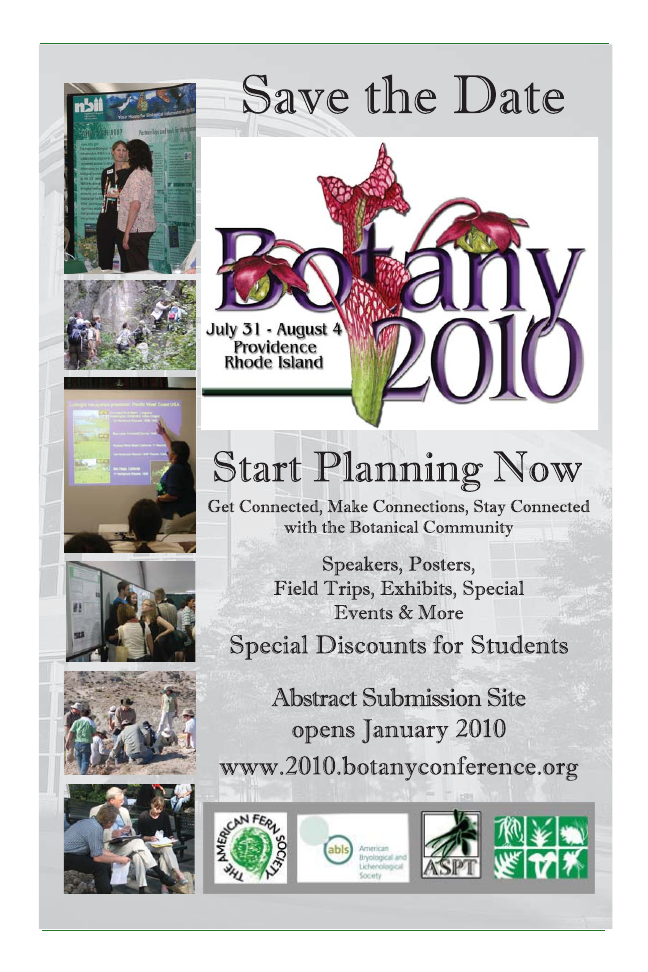
100
Plant Science Bulletin 56(2) 2010